ACS | Collector’s Conifer of the Year
The American Conifer Society chooses a small collection of rare conifers each year to educate the public on the wonderful world of cone-bearing evergreens and where to buy these incredible specimens.
Eight dwarf and semi-dwarf rare and unusual conifers have been featured in the 2020 American Conifer Society Collection. These conifers highlight the beautiful eccentricity of the conifer kingdom and create permanent showcase elements in the landscape.
Most of the specimens on the list are fairly new arrivals; only a handful of certified nurseries keep them in stock. This is especially intriguing for homeowners looking to add something different to help add interest and flair to their landscapes.
But first, who is the wonderful organization who makes these collections?
What is the American Conifer Society?
The American Conifer Society was organized in 1983 with the focus of preserving and propagating conifers, as well as educating others on the fascinating world of gymnosperms.
What began as a small organization of 80 conifer enthusiasts has now quickly spread across the continental United States with more than 1,600 members.
Since 2006, the American Conifer Society chooses exceptional conifer specimens annually and highlights them on their website. These can be found here.
These conifers are rarely available to the public, but the American Conifer Society helps connect gardeners with certified rare conifer nurseries so they can feature these plants in their gardens.
Interested in becoming a member? Learn more here.
American Conifer Society’s 2020 Collectors’ Conifer of the Year
The ACS has chosen eight spectacular conifer species to highlight for the 2020 Collectors’ Conifer of the year.
These specimens have unique color patterns, and most have a dwarf growth habit. Each one is worthy of a special place in the landscape.
The following table is the American Conifer Society’s selections for the 2020 Collectors’ Conifer of the Year:
| Year | Scientific Name | Common Name | Zone | Growth Rate | Key Features |
|---|---|---|---|---|---|
| 2020 | Abies concolor “Archer’s Dwarf” | Archer’s Dwarf White Fir | 4-8 | Dwarf | Silver-blue needles, upright habit |
| 2020 | Abies lasiocarpa “Green Globe” | Green Globe Subalpine Fir | 4-8 | Dwarf | Green needles, globular growth habit |
| 2020 | Gingko biloba “Clica” | Clica Maidenhair Tree | 4-8 | Dwarf | Light green leaves, ruffled margins |
| 2020 | Picea abies “Acro-yellow” | Acro-yellow Norway Spruce | 3-8 | Dwarf | Bright yellow needles, red cones |
| 2020 | Pinus koraiensis “Morris Blue” | Morris Blue Korean Pine | 3-8 | Intermediate | Long, silver-blue needles, upright habit |
These conifers are rare specimens. Purchase your own conifers from nurseries that specialize in rare and dwarf conifers to ensure the highest possible quality.
Abies concolor ‘Archer’s Dwarf’

Archer’s Dwarf is a silvery blue, upright dwarf with soft, incurved needles.
This conifer has a dense, predictable growth habit, and the branches will form a layered look over time. As the tree matures, it will form a conical shape, although it can be pruned into a round shape.
This shrub grows 3”-4” per year and can reach 6’ tall and 3’ wide without pruning.
Archer’s Dwarf grows well in full sun or part shade, as long as the soil is well-drained, fertile, and slightly acidic.
This specimen is perfect for landscapes, rock gardens, container gardens, city gardens, and cottage gardens.
Abies lasiocarpa ‘Green Globe’
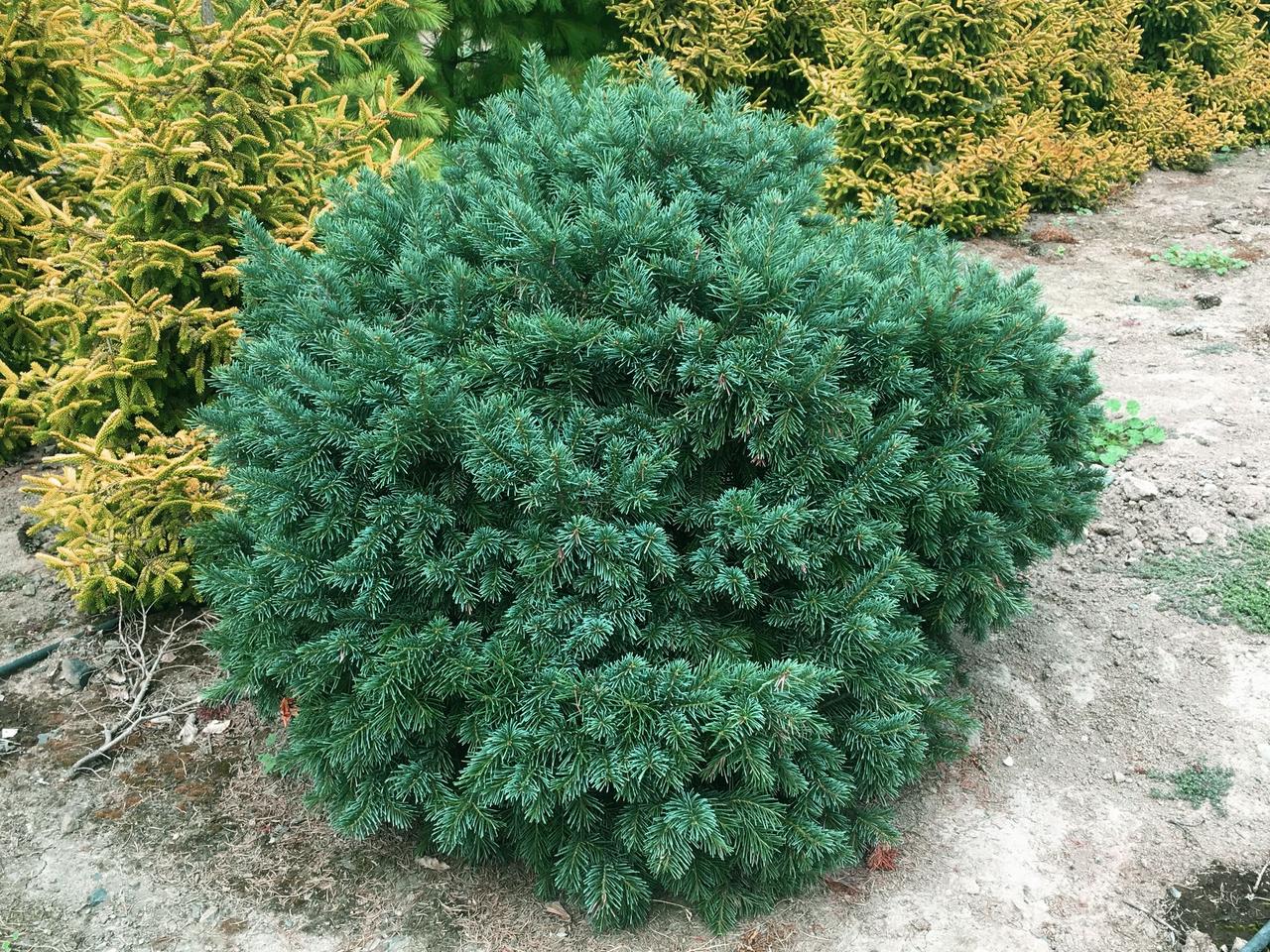
Green Globe is a semi-dwarf shrub with soft, short, light-green needles.
This conifer has a dense, globular growth habit, and the branches appear to sprout from the center of the shrub. As the plant grows and matures, it will form a slightly conical shape unless it is pruned.
This shrub grows 3”-6” per year and can reach 5’ tall and 5’ wide without pruning.
Green Globe grows well in full sun and moist, well-drained, acidic soils.
This specimen is perfect for landscapes, rock gardens, city gardens, and cottage gardens.
Gingko biloba ‘Clica’
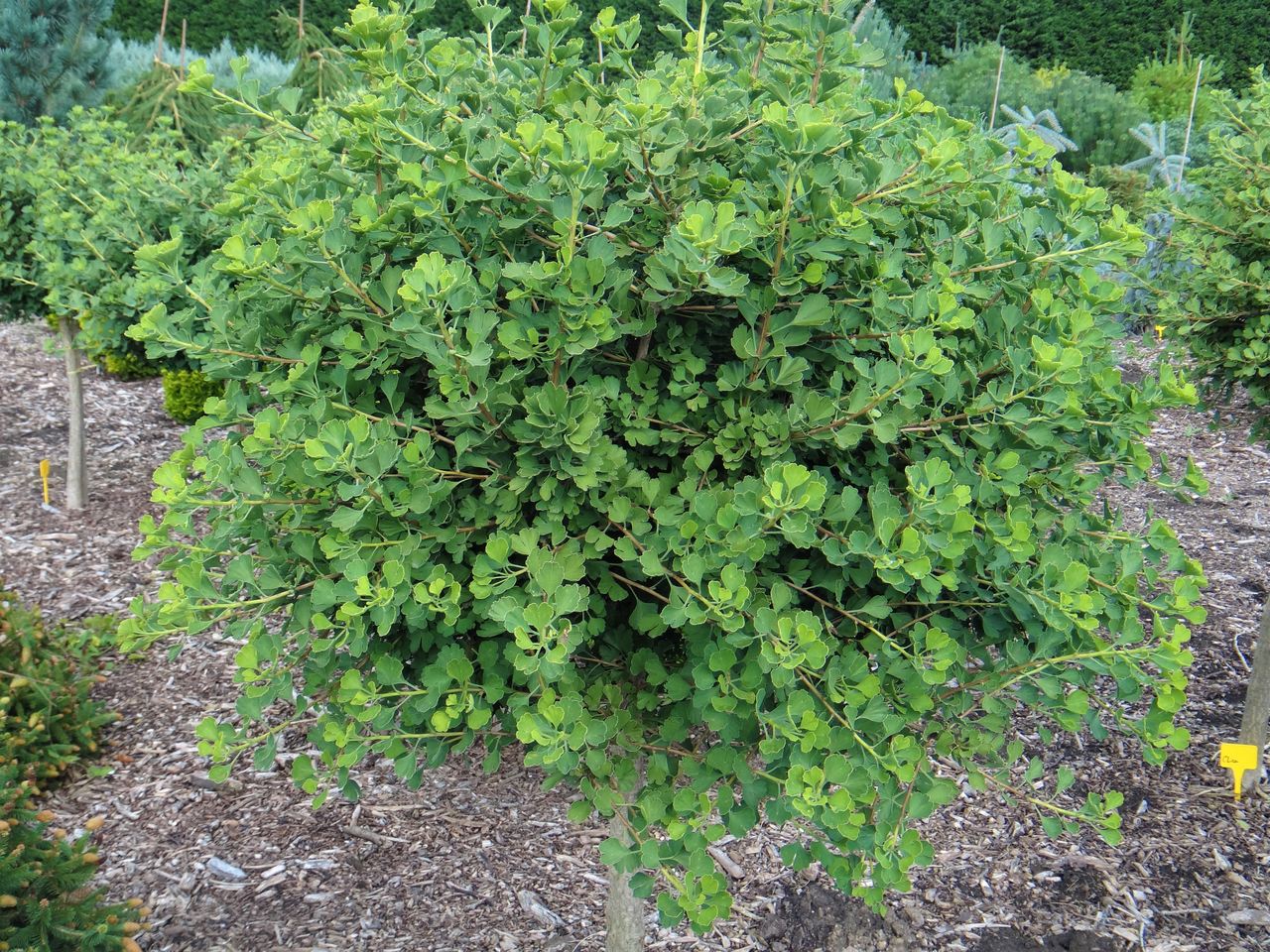
The Clica Maidenhair tree is a dwarf, multi-branched shrub with soft, ruffled leaves.
This tree has a dense, upright growth habit. The branches extend up and out from the center of the plant. As the tree matures, it can become more wide than tall.
This tree grows 3-4” per year and can reach 3’ tall and 4.5’ wide without pruning.
Clica grows well in full sun to part sun and in well-drained soils.
This specimen is perfect for landscapes and container gardens.
Picea abies ‘Acro-yellow’
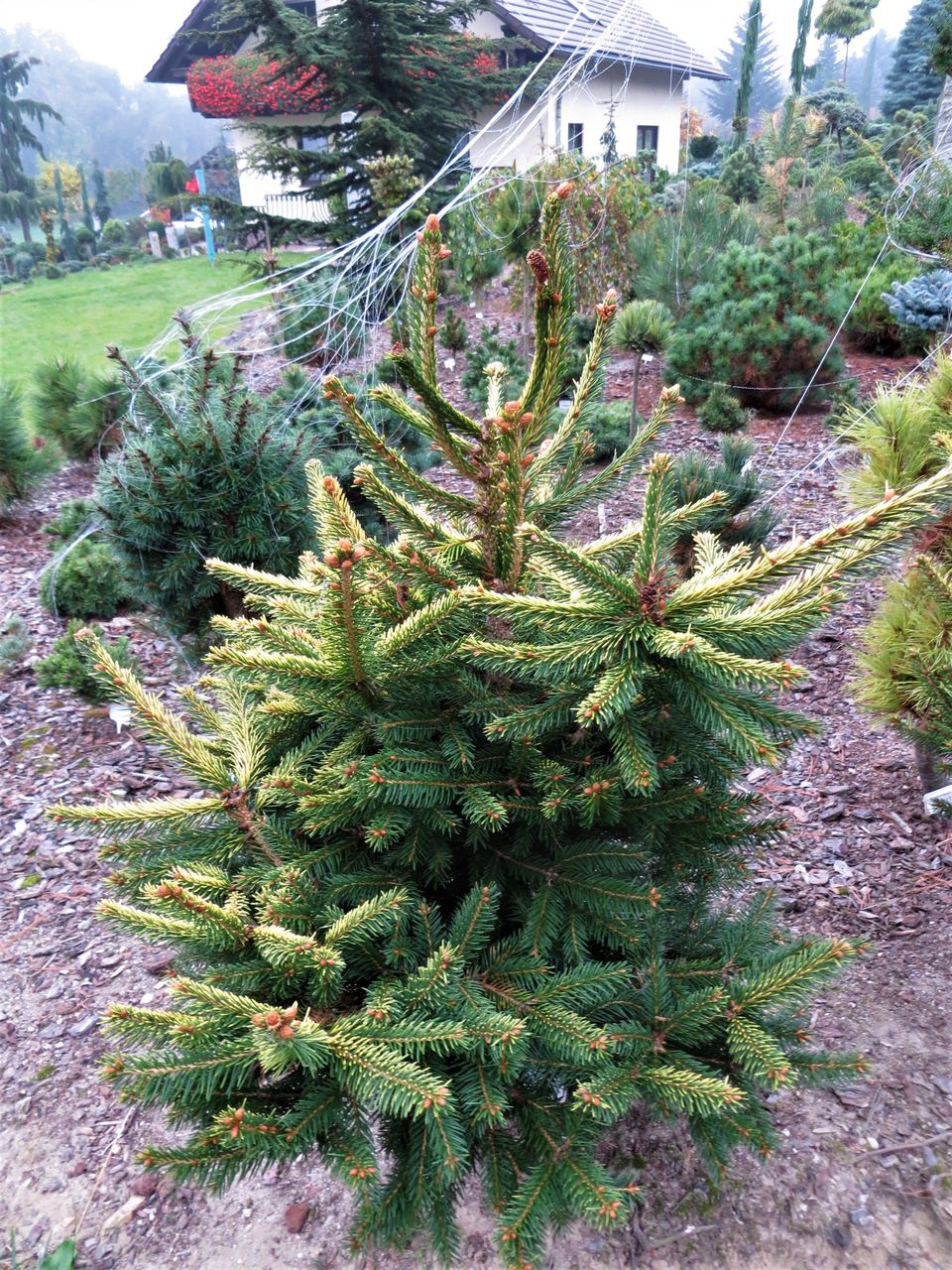
This bright yellow Norway Spruce has striking cherry-red cones in the spring.
This tree has a moderately dense, upright growth habit. The branches extend out vertically from the trunk. As the tree matures, it forms a traditional Christmas tree shape.
This tree grows 3”-5” per year and can reach 5’ tall and 3’ wide without pruning.
Acro-yellow grows well in full sun to part shade and in well-drained, acidic soils.
This specimen is perfect for landscapes, rock gardens, and container gardens.
Pinus koraiensis ‘Morris Blue’
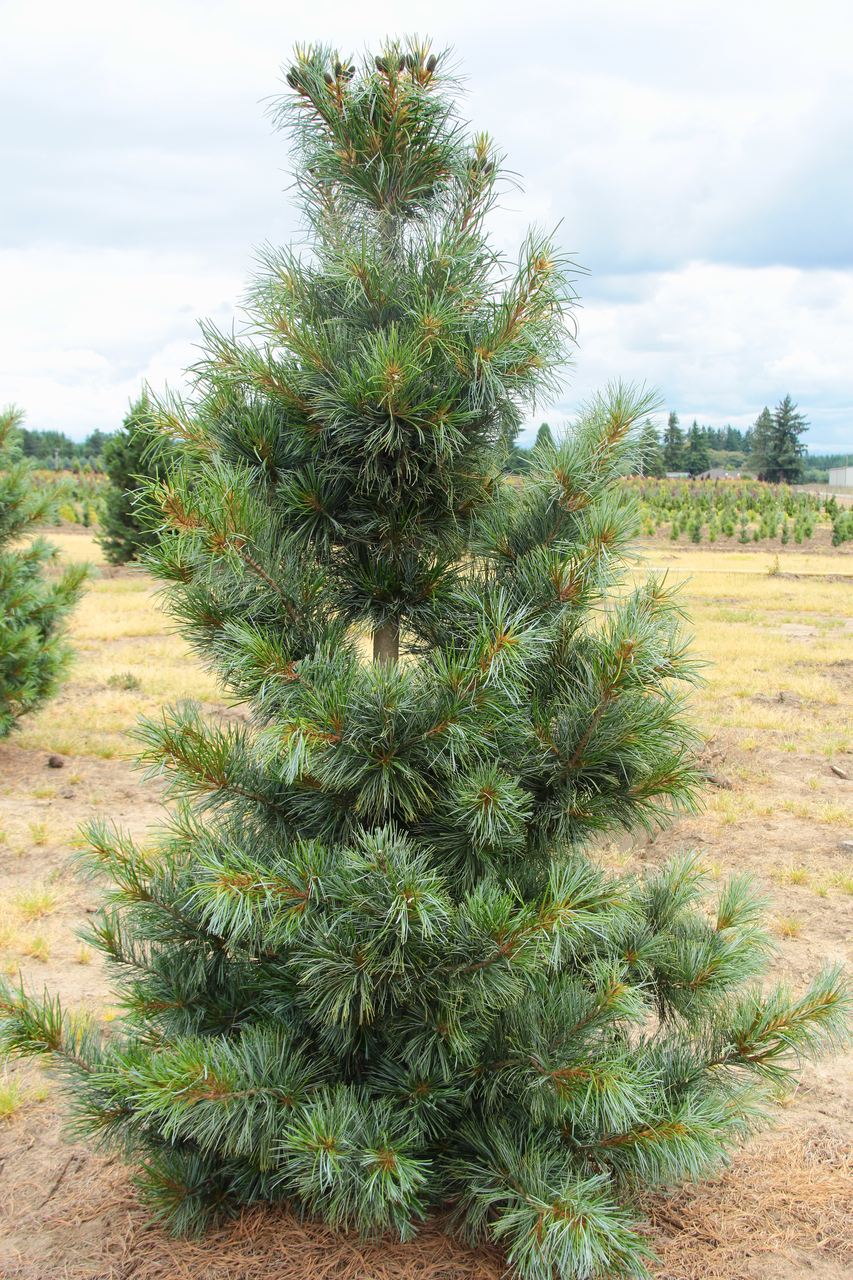
This shaggy Korean pine has long, silver-blue needles and distinct, upright branches.
Morris Blue has an open, pyramidal growth habit. The branches are thick and bushy, and they curve upwards at the ends. As the tree matures, it forms a bushy pyramid and reveals an open structure with grey, shaggy bark.
This tree grows 6”-9” per year and can reach 8’ tall and 4’ wide without pruning.
Acro-yellow grows well in full sun to part shade and well-drained, acidic soils.
This specimen is used primarily as a lawn tree or accent plant in the landscape.
Pinus contorta var. latifolia ‘Taylor’s Sunburst’
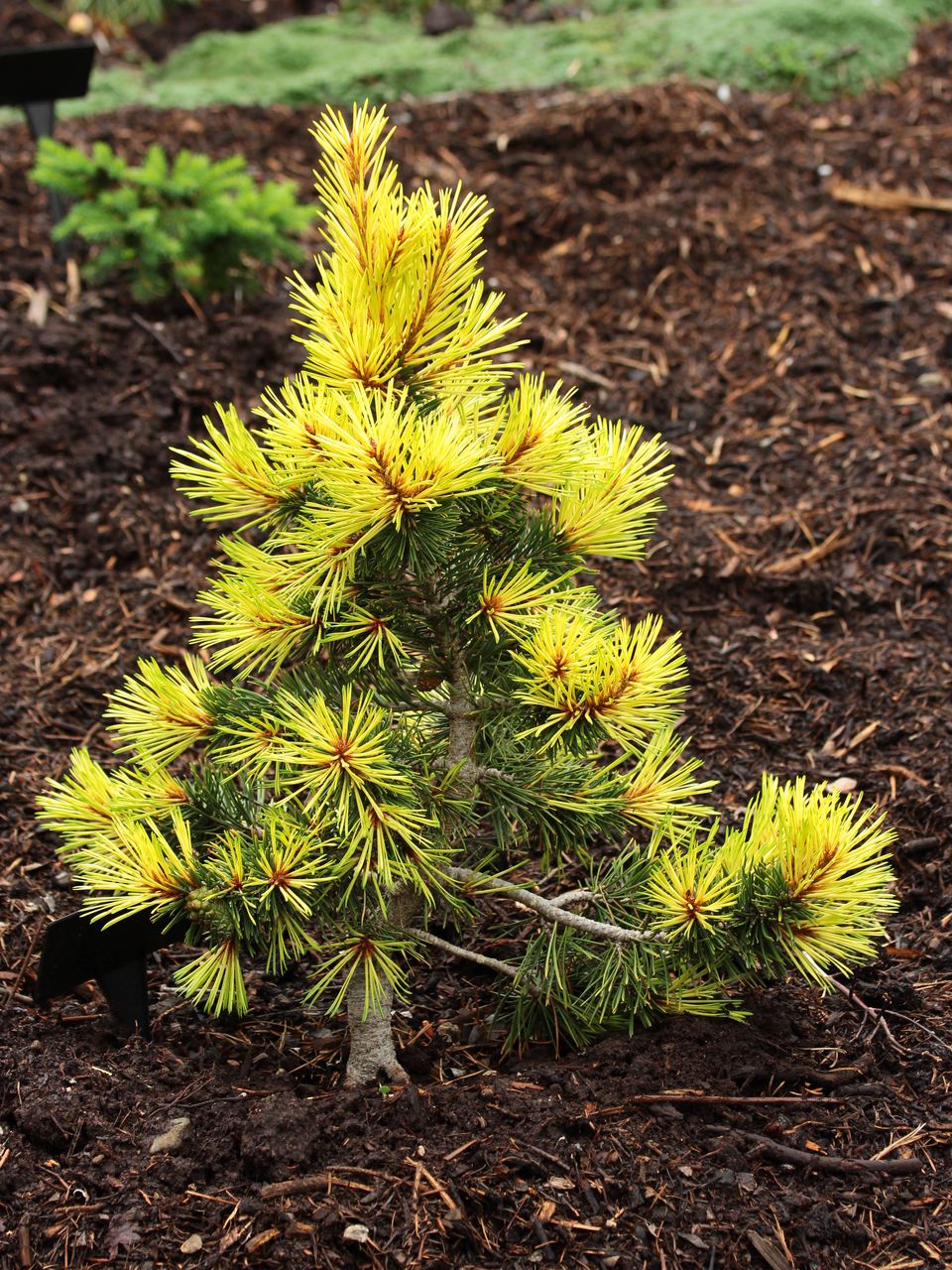
Taylor’s Sunburst has a flush of bright gold growth in the spring, which is accented by fiery red cones.
This lodgepole pine has an open, upright, pyramidal growth habit. The branches are dense with needles, and curve up at the tips. As the tree matures, it forms a wide, open pyramid which reveals a textured, burnt-red bark.
This tree grows 6”-12” per year and can reach 15’ tall and 10’ wide without pruning.
Taylor’s Sunburst grows well in full sun to part sun and in well-drained, acidic soils.
This specimen is used primarily as a lawn tree or accent plant in the landscape or in city gardens because of its high pollution tolerance.
Pinus mugo ‘Paul’s Dwarf’
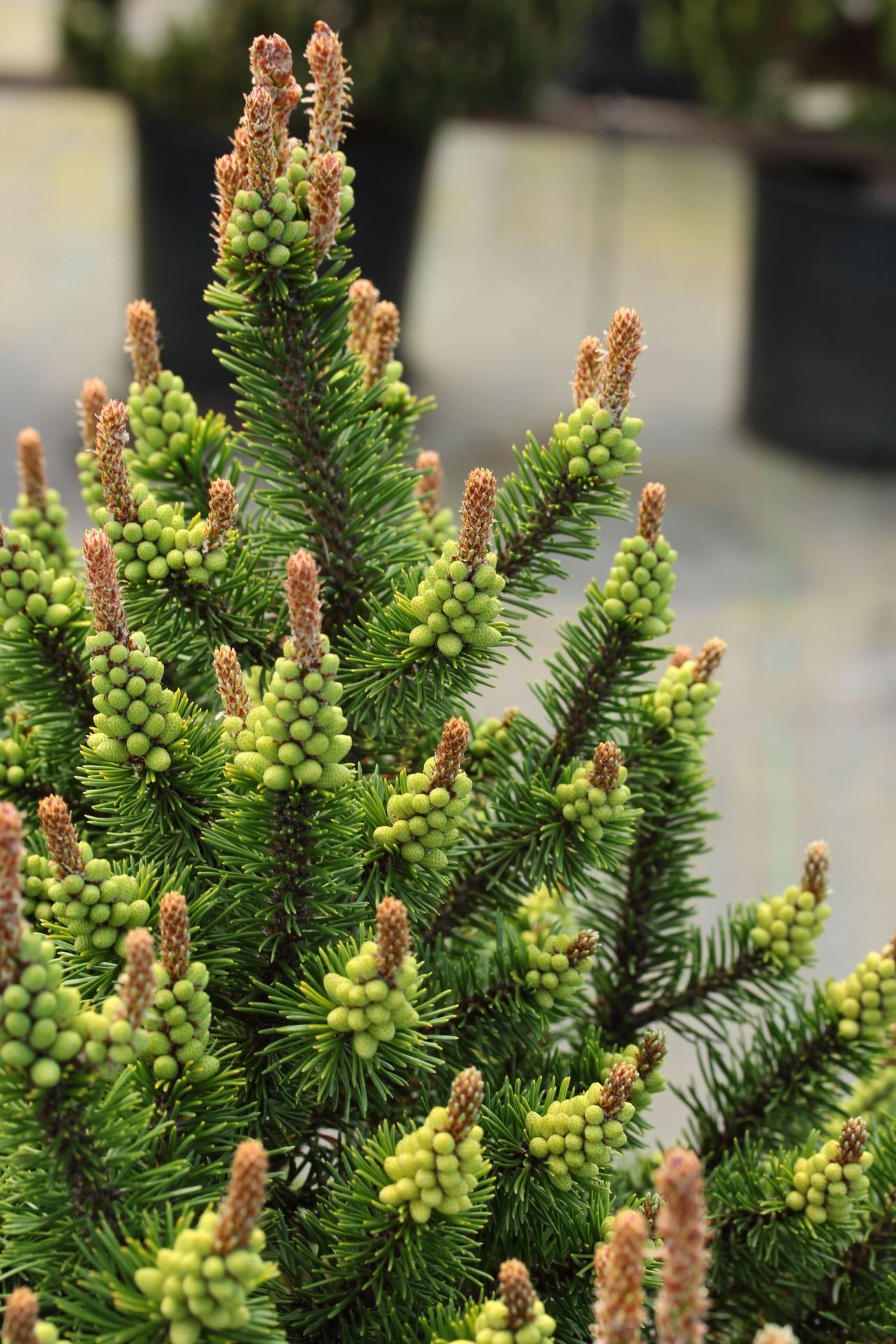
Paul’s Dwarf has short pairs of dark-green needles on dense, upright branches.
This extremely compact pine has an upright, globose growth habit. As the shrub matures, it forms a dense, mounding evergreen which may outgrow the designated area without annual pruning.
This shrub grows 2”-3” per year and can reach 3’ tall and 3’ wide without pruning.
Paul’s Dwarf grows well in full sun and well-drained, loamy, acidic soils.
This specimen is used in landscapes, rock gardens, container gardens, and as bonsai specimens.
Pinus thunbergii ‘Shirome Janome’
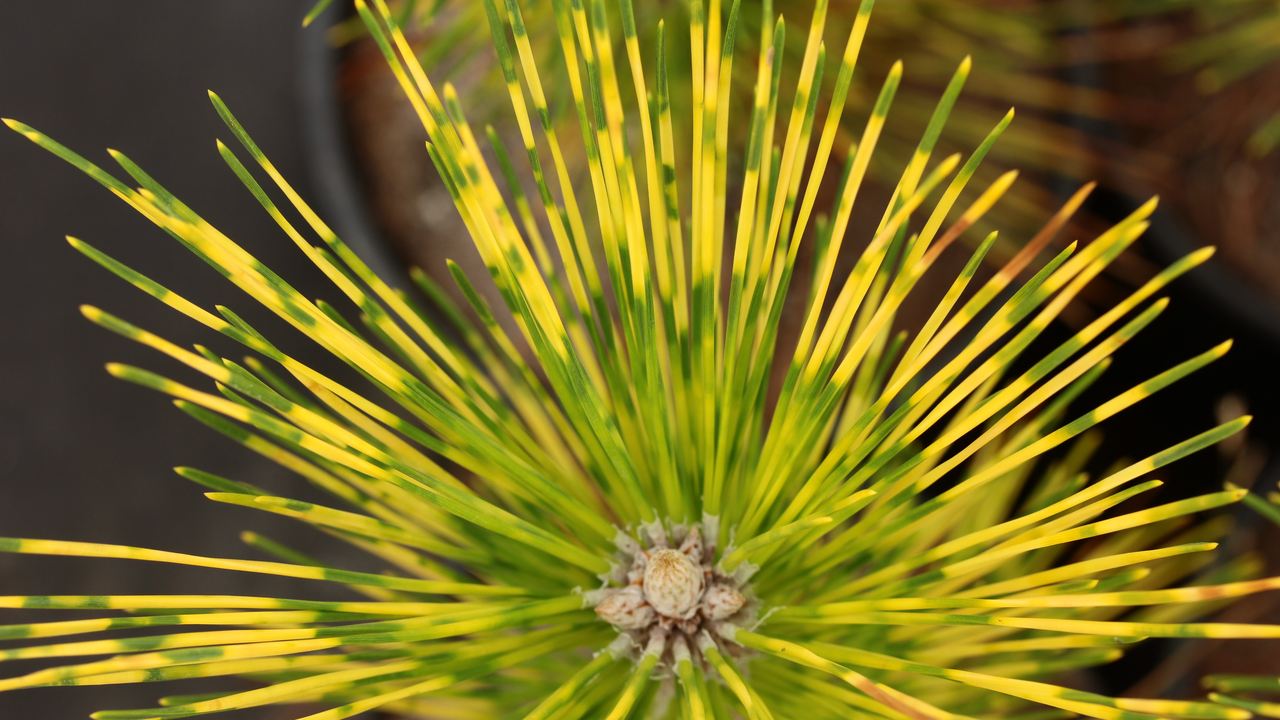
This unique Japanese black pine has green and yellow variegated foliage throughout the growing season.
Shirome Janome has an open, irregular growth habit. The branches are full of long, colorful needles with a sporadic branching habit.
This tree grows 6”-12” per year and can reach 10’ tall and 7’ wide without pruning.
Shirome Janome grows well in full sun and well-drained, acidic soils.
This specimen is used primarily as a lawn tree or accent plant in the landscape.
Abies cephalonica ‘Meyer’s Dwarf’
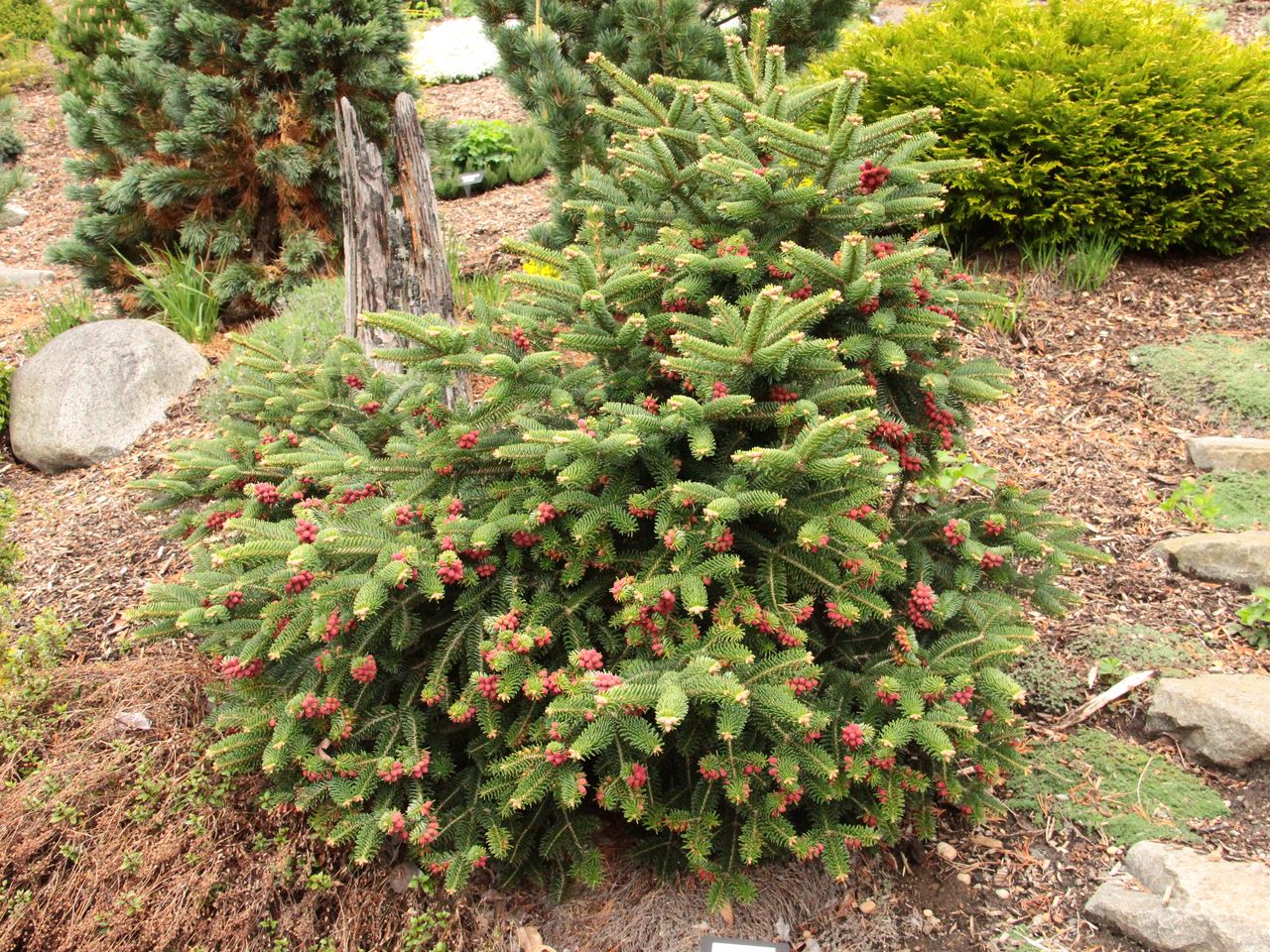
This Grecian fir has dark-green needles that are short and somewhat spiky and contrast nicely with its small red cones.
Meyer’s Dwarf typically has an upright, pyramidal growth habit. Depending on how it’s propagated, Meyer’s Dwarf may have more of a mounding, spreading form. The branches curve downward slightly at the ends.
This tree grows 3”-6” per year and can reach 1.5’ tall and 3’ wide without pruning.
Meyer’s Dwarf grows well in full sun or part shade and well-drained, acidic soils.
This specimen is used primarily as a ground cover, border, or rock garden accent.
Cedrus libani ‘Katere’
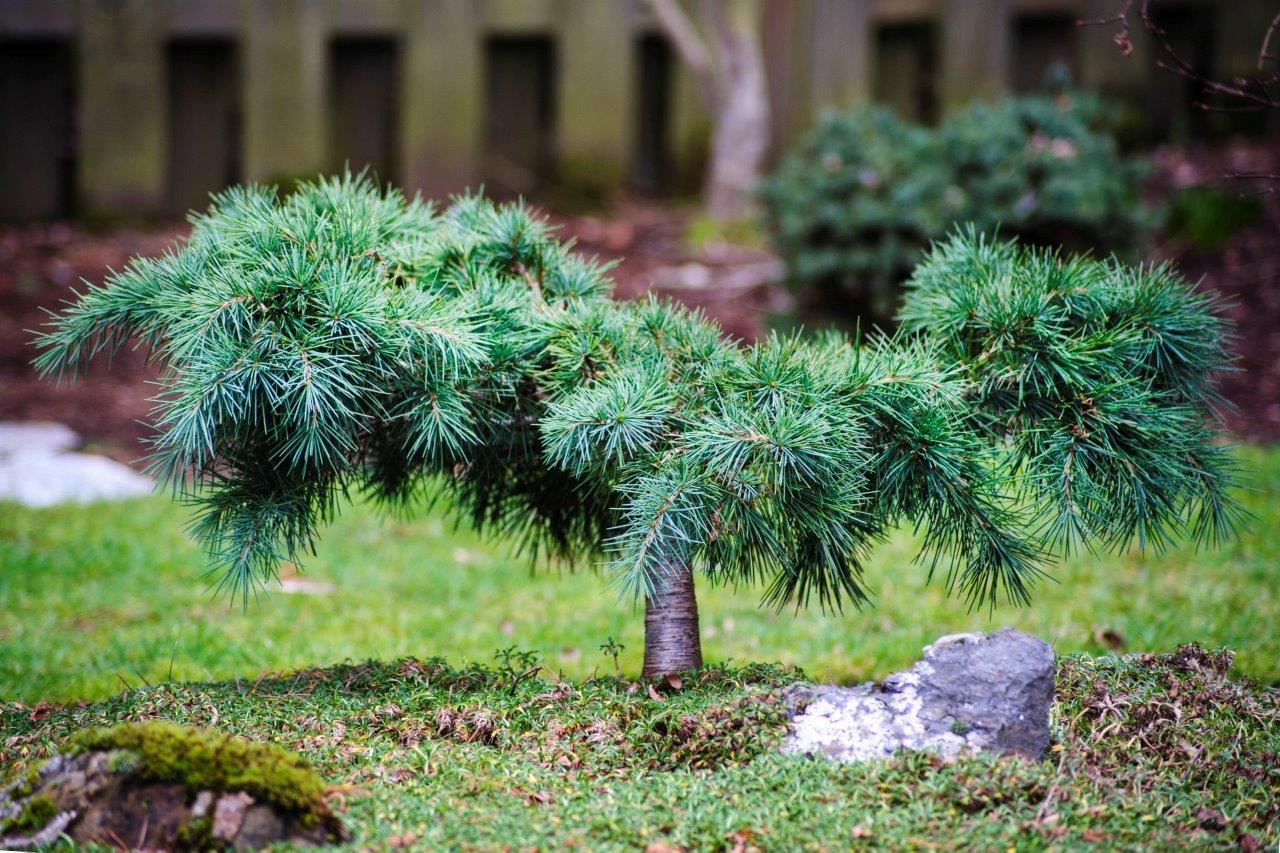
This Lebanese cedar features long gray-green needles and dense growth.
Katere spreads horizontally, giving it a prostrate form that is almost flat.
With an annual growth of 1”-2”, Katere is among the slowest-growing Cedars of Lebanon. After 10 years, this tree will measure approximately 10” tall and wide.
Katere grows well in full sun and well-drained soils.
Because of its small size, this specimen works well in rock gardens or other small garden spaces.
Chamaecyparis lawsoniana ‘Filip’s Golden Tears’
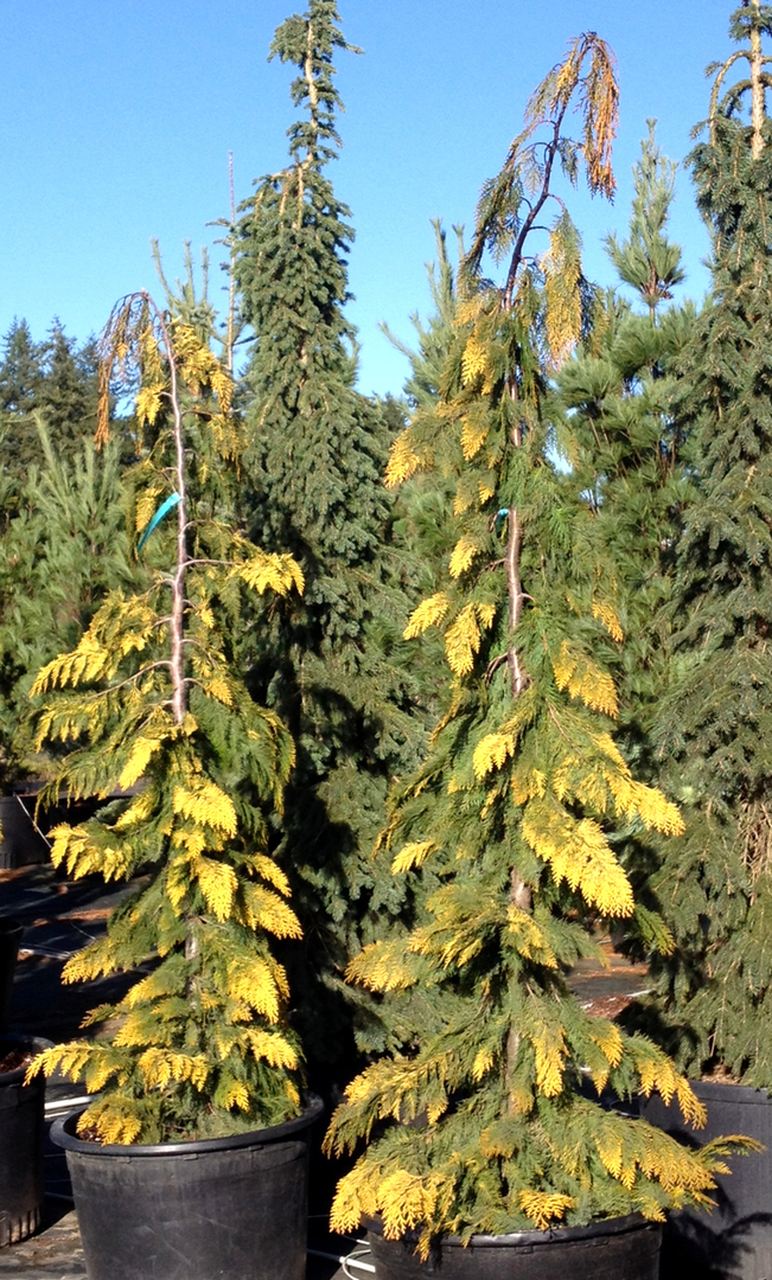
Filip’s Golden Tears features green foliage with golden highlights that give it a variegated appearance.
This tree is upright and very narrow with weeping branches.
Filip’s Golden Tears grows at a rate of 18”-24” per year, and most of that growth is vertical. After 10 years, this tree will reach 15’ tall but only 2’ wide.
Filip’s Golden Tears grows well in full sun and well-drained soils.
This specimen is used primarily as a lawn tree or garden accent.
Picea abies ‘Lemonade’
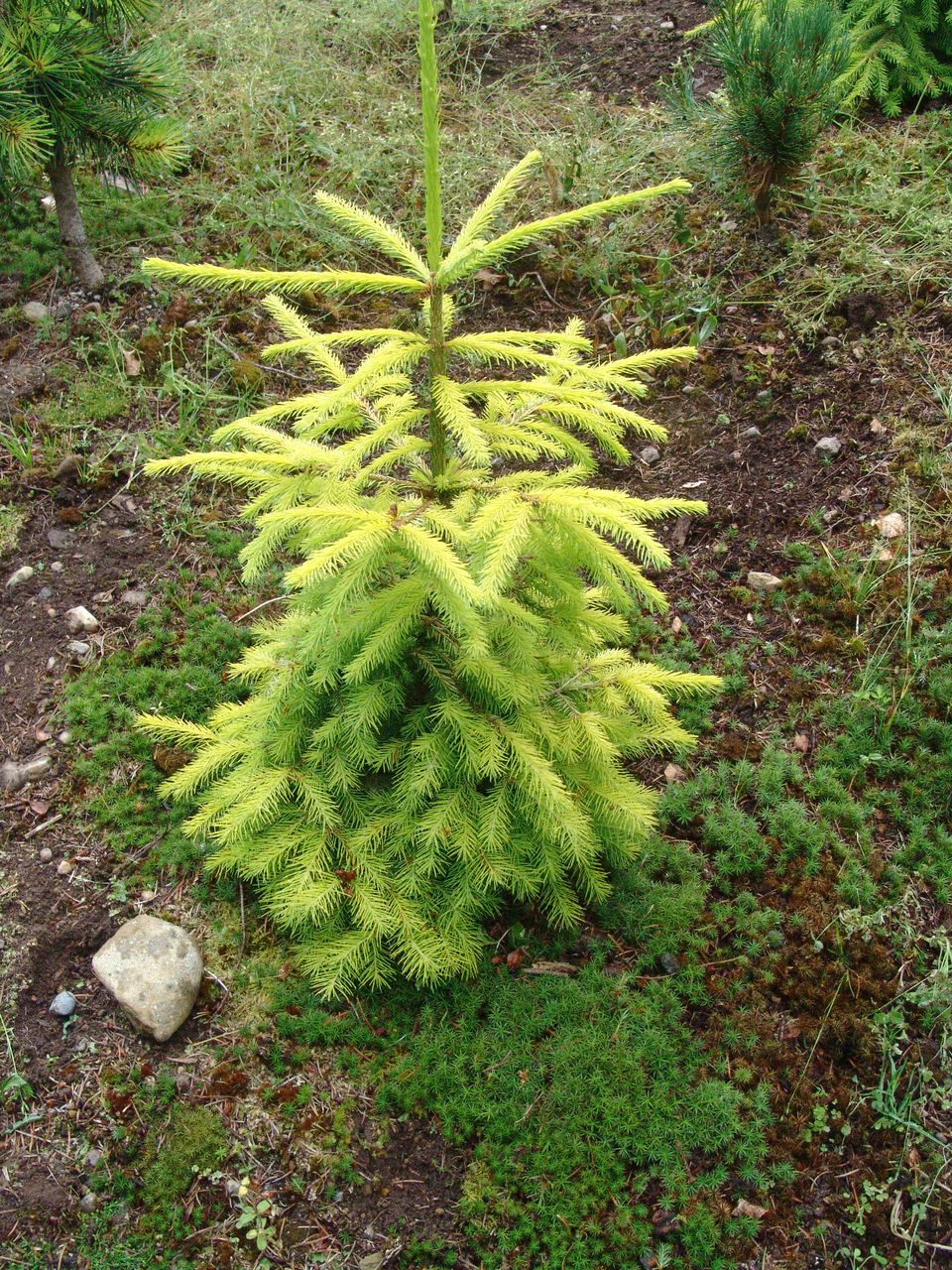
This rare Norway Spruce has bright golden needles whose color becomes even brighter in the winter. The needles are short and dense. It doesn’t produce cones.
Lemonade Norway Spruce has a broadly pyramidal form with semi-pendulous branches.
This vigorous tree grows over 1’ per year. At full maturity, Lemonade will reach 12’ tall and 8’ wide.
Lemonade grows well in full sun and well-drained soils.
This specimen is used primarily as a lawn tree or garden accent.
Picea orientalis ‘Ferny Creek Prostrate’
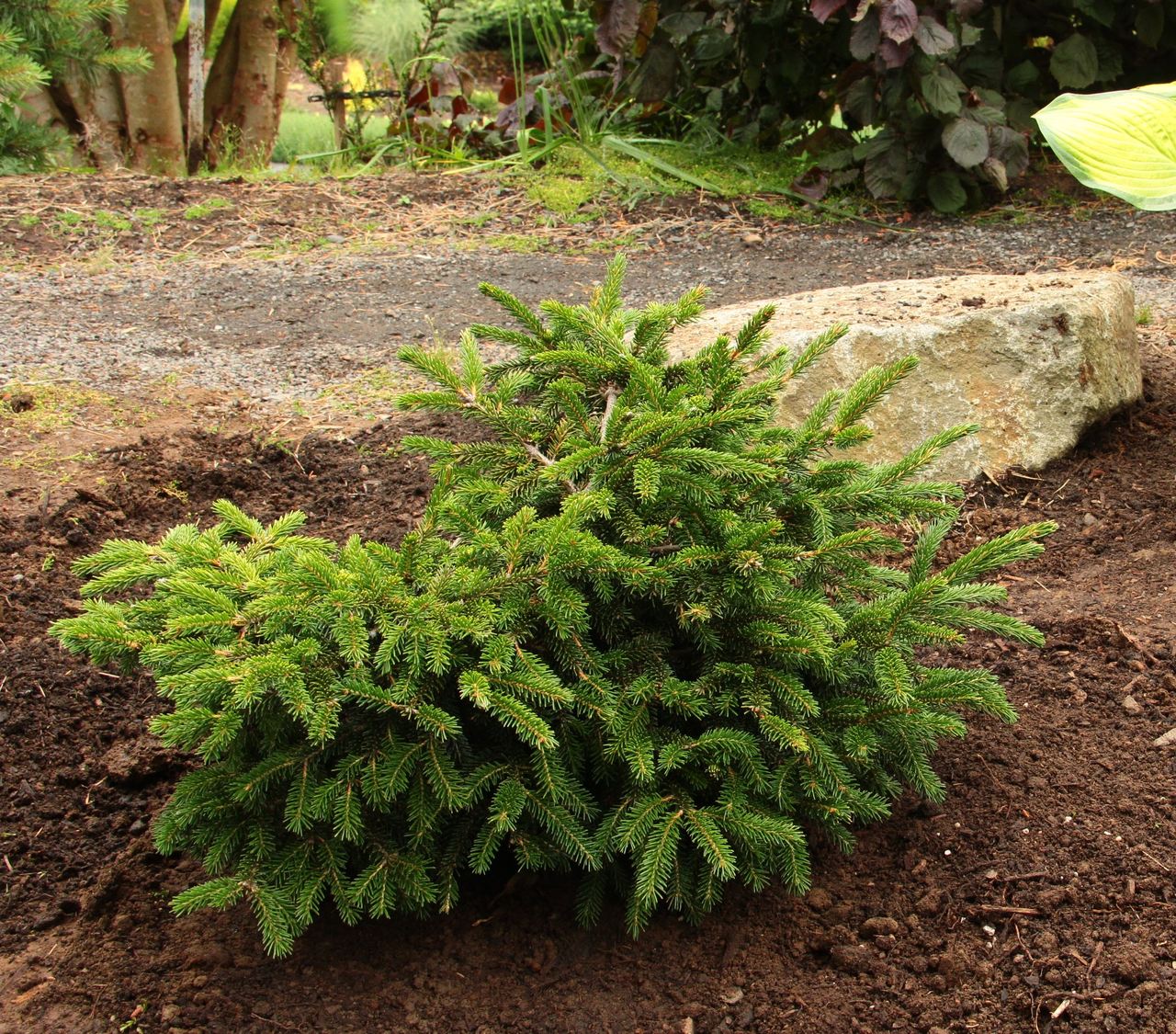
This unusual shrub features dark-green needles that are very short and radiate around each branch.
As its name suggests, Ferny Creek Prostrate has a flat, spreading habit.
This shrub grows approximately 2”-4” per year, mostly in a horizontal direction. When mature, Ferny Creek Prostrate is only 2’ tall but 4’ wide.
Ferny Creek Prostrate grows well in full sun and well-drained soils.
Because of its small size, this specimen works well in rock gardens or other small garden spaces.
Picea pungens ‘Blue Pearl’
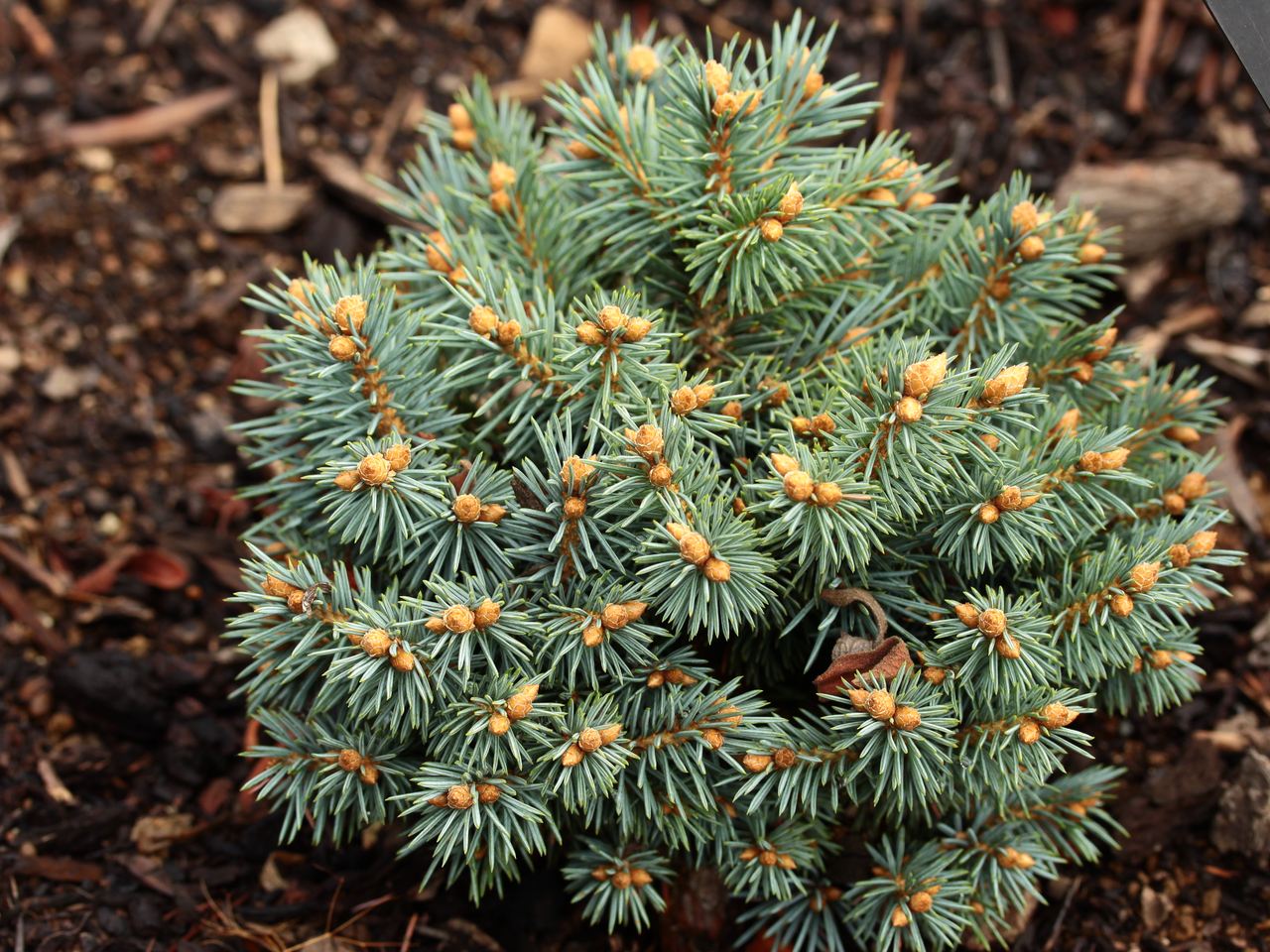
As its name suggests, Blue Pearl has blue, prickly needles that contrast nicely with its orange-brown buds.
Blue Pearl’s dense, globular branches create a cushion shape. The branches radiate from the main trunk and angle slightly upward.
The word “cute” comes to mind when looking at this miniature spruce. It grows 1” or less per year, and at full maturity, will be approximately 6” tall and 12” wide.
Blue Pearl grows well in full sun and well-drained soils.
Because of its small size, this specimen works well in rock gardens, small garden spaces, or as a dwarf landscape feature.
Pinus parviflora ‘Catherine Elizabeth’
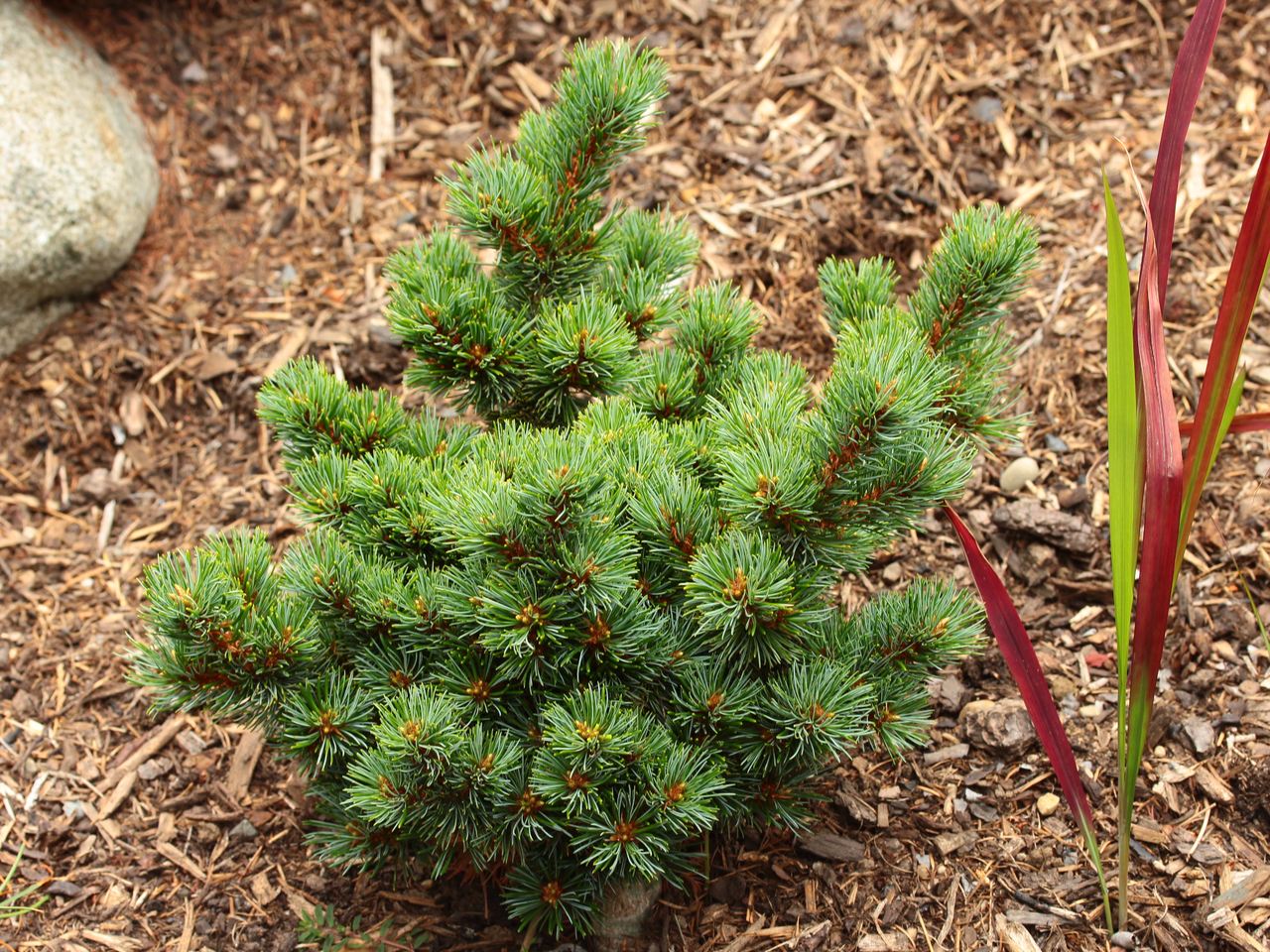
This unusual specimen of Japanese White Pine features short, blue-green needles.
Catherine Elizabeth’s foliage is clumpy and bushy. The branching is irregular, and with age, the tree spreads horizontally, creating a broad globose or pyramidal form.
This tree’s annual growth ranges from 2”-4”. After ten years, Catherine Elizabeth will approximately 2’ tall and 3’ wide. Yearly pruning is recommended to remove old branches or foliage that has collected in the tree’s interior branches.
Catherine Elizabeth grows well in full sun and well-drained soils.
Because of its small size, this specimen works well in rock gardens, small garden spaces, or as a dwarf landscape feature.
Cedrus atlantica ‘Sapphire Nymph’
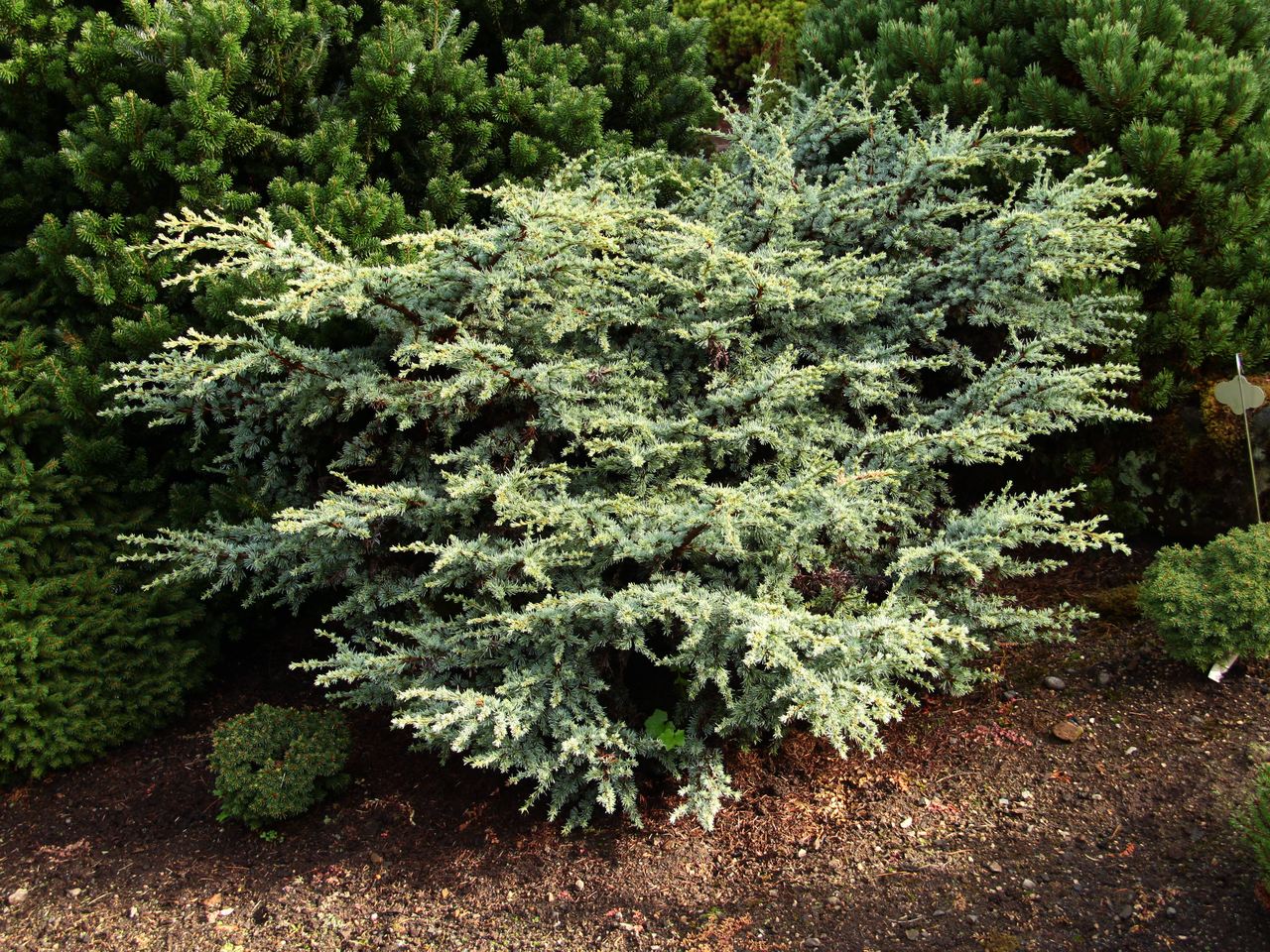
This tree has short, silver-blue needles that are stiff and dense. The needles spiral outward from their stems.
Sapphire Nymph’s form is low-growing and broadly pyramidal. Growers can stake Sapphire Nymphs, which allows them to cascade from the height of the stake.
This tree will grow 1”-3” per year. At full maturity, Sapphire Nymph will be about 10” tall and 30” wide.
Sapphire Nymph grows well in full sun and well-drained soils.
This specimen is hard to propagate, and its branches can be delicate. It will do well in rock gardens or small garden spaces.
Platycladus orientalis ‘Franky Boy’
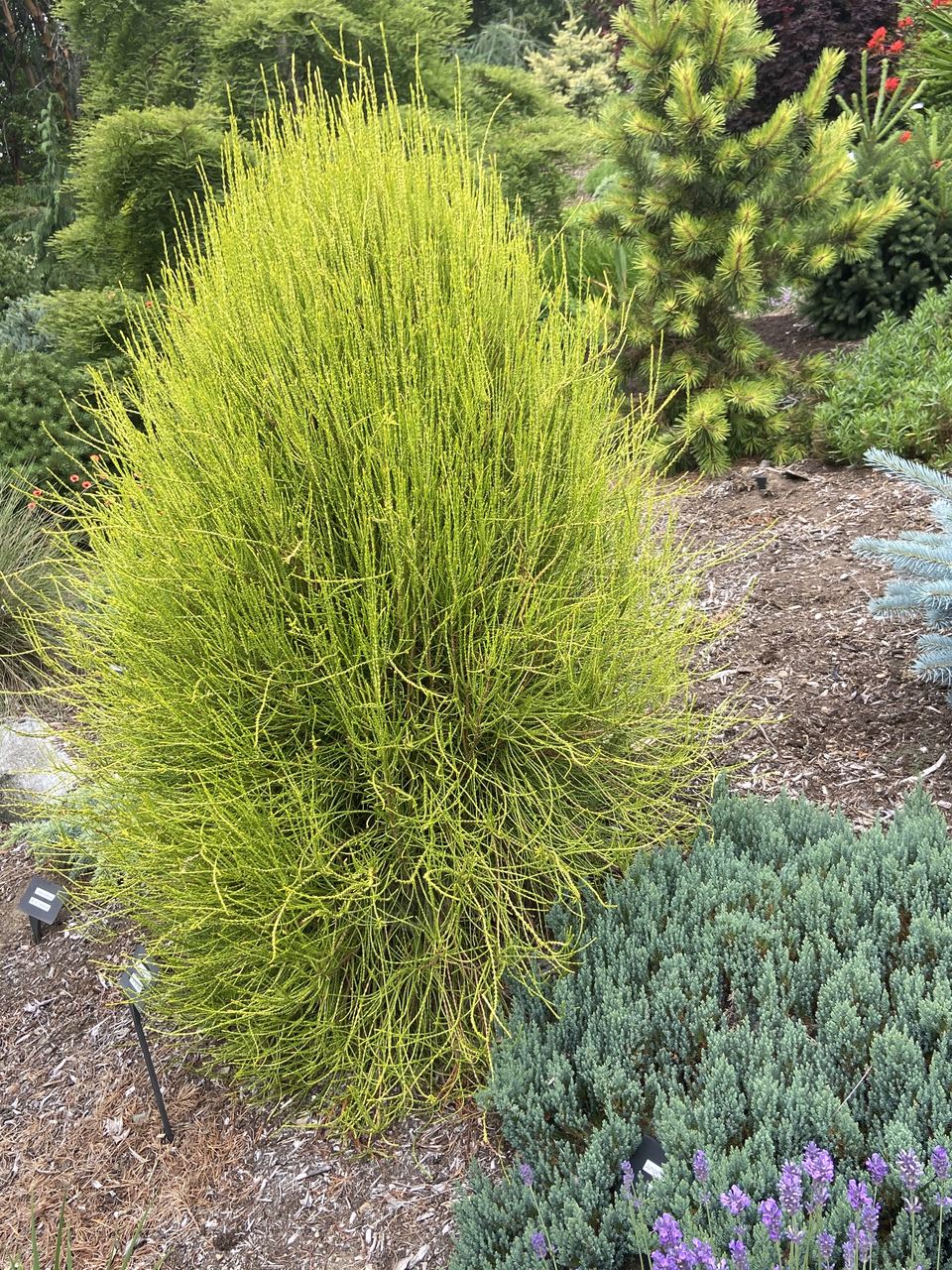
This unusual conifer’s foliage resembles ornamental grasses. Its interior foliage is lime green, while its exterior foliage is bright yellow. In the summer, the yellow is more pronounced; in fall and winter, it takes on more orange and bronze tones.
Franky Boy’s branches are filamentous, light-textured, and upright, which adds to its resemblance to ornamental grasses.
This tree grows 3”-6” per year, reaching 6’ high and 4’ wide at full maturity. Light pruning will encourage new growth and allow growers to maintain its graceful form.
Franky Boy grows well in full sun, where its color will become more intense, and well-drained soils.
This specimen is used primarily as a lawn tree or accent plant in the landscape.
Thuja occidentalis ‘Islprim’ Primo®
Islprim Primo® Arborvitae
This tree features lush, deep-green summer foliage that turns a more muted green in the winter. The foliage is twisted and compact which creates a unique, textured appearance.
Islprim’s twisted foliage and upright form produce a narrow, sculptured shape.
This tree grows 3”-5” per year. At full maturity, it measures approximately 4’ high and 1’ wide.
Islprim grows well in full sun and well-drained soils.
This specimen is used primarily in rock gardens, container gardens, or as a landscape accent.
Chamaecyparis lawsoniana ‘Blue Surprise’
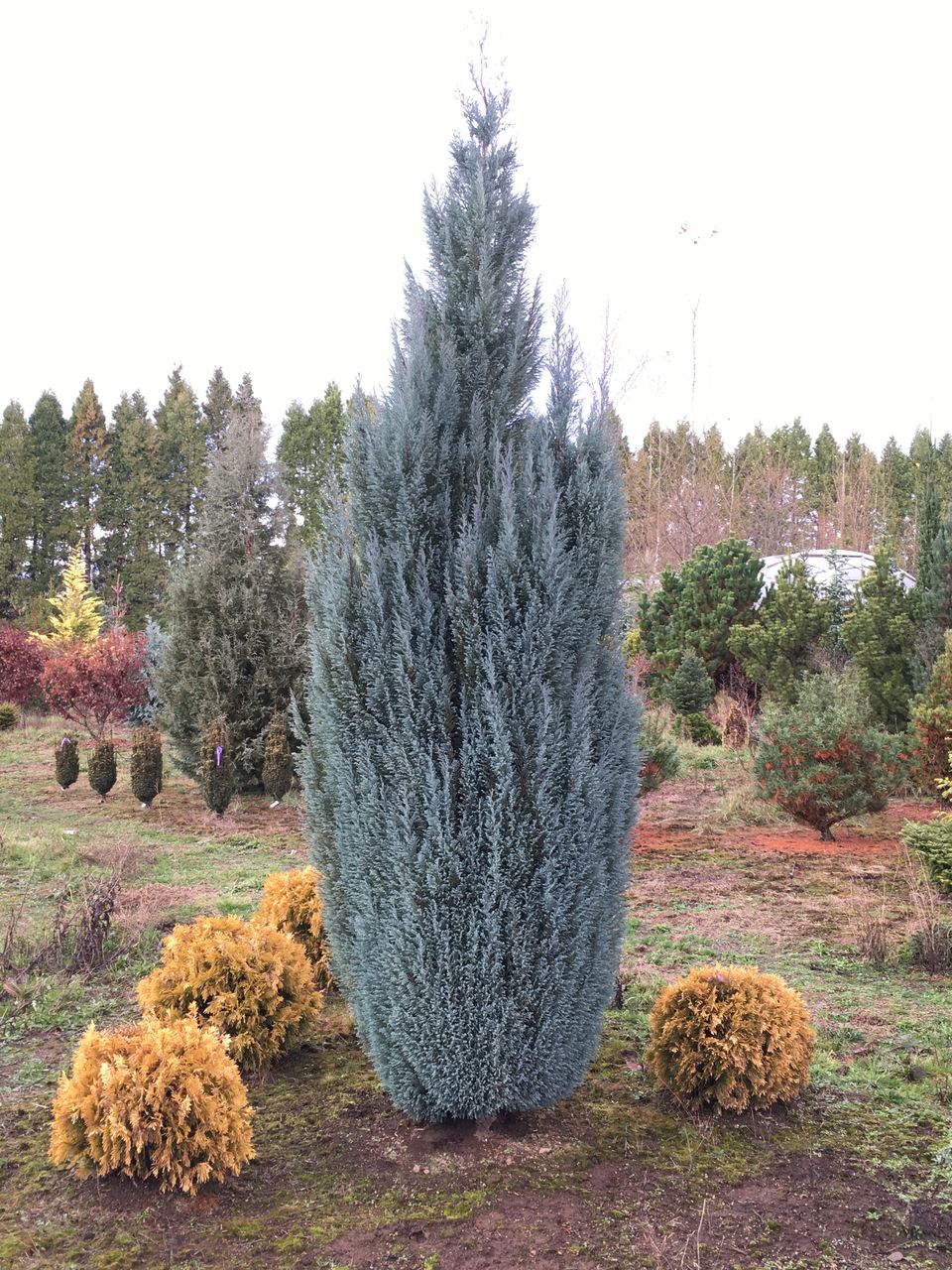
This tree is visually striking in both summer and winter. In the summer, its foliage is bright blue; in the winter, it takes on a plum purple color. Its foliage is also soft and feathery, which gives it a unique texture as well as unique color.
Blue Surprise is columnar in shape and very narrow. Its branches grow strictly upward.
Annually, this tree grows 3”-5”. After ten years, it will be approximately 5’ tall and 1.5’ wide.
Blue Surprise grows well in full sun and well-drained soils.
This specimen is used primarily as a lawn tree or accent plant in the landscape.
Picea pungens ‘Ruby Teardrops’
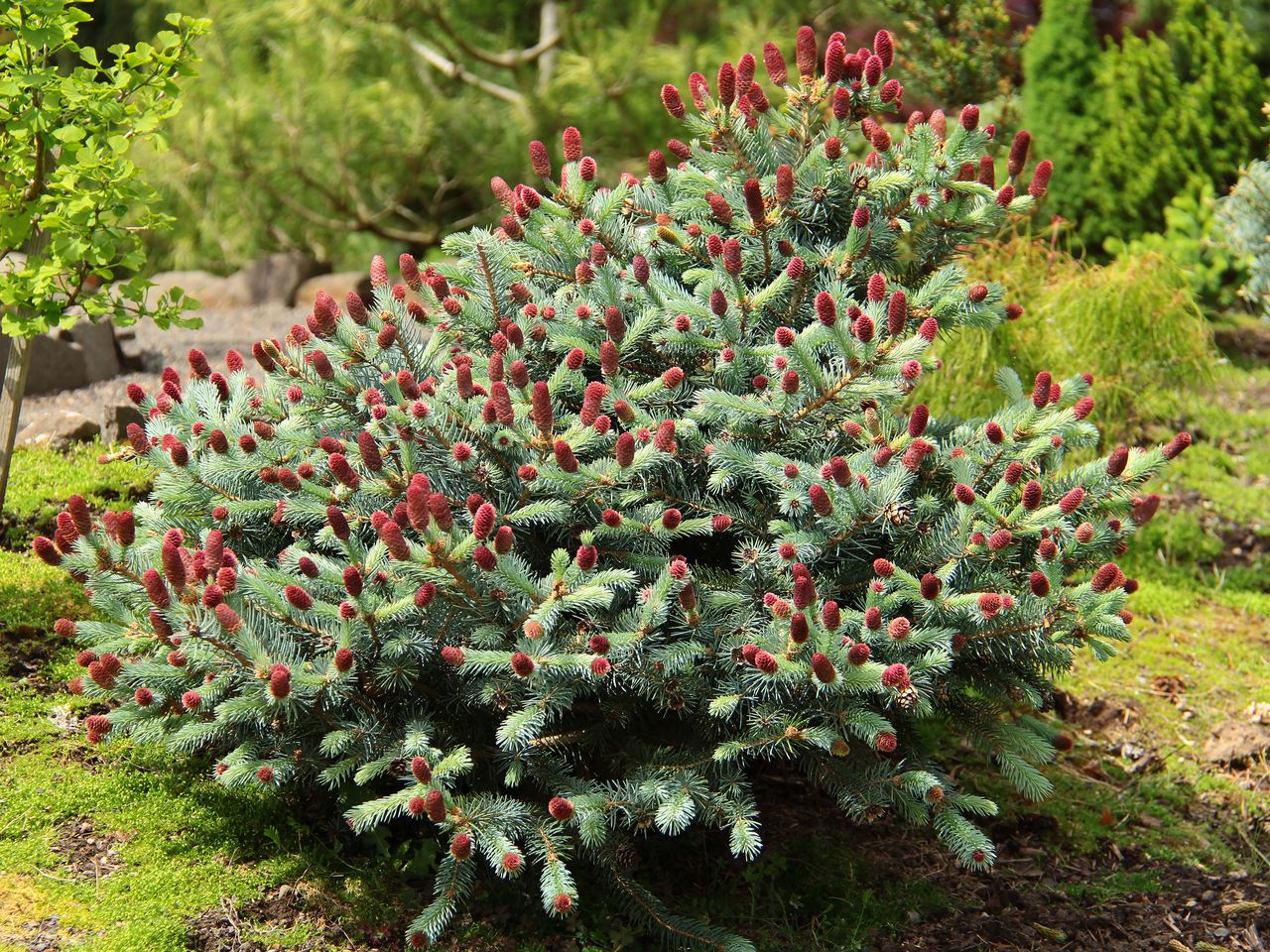
This rare Colorado Spruce features a striking color combination, with blue-green foliage and cones that are red or magenta in the spring. In the summer, its foliage becomes a lighter sky blue.
Ruby Teardrops’ form is irregular, globose, and spreading.
This tree grows approximately 2”-4” per year. After ten years, it will be about 2’ tall and 3’ wide.
Blue Surprise grows well in full sun and well-drained soils.
Because of its color, Blue Surprise is used as a garden or landscape accent.
Thuja occidentalis ‘Jantar’
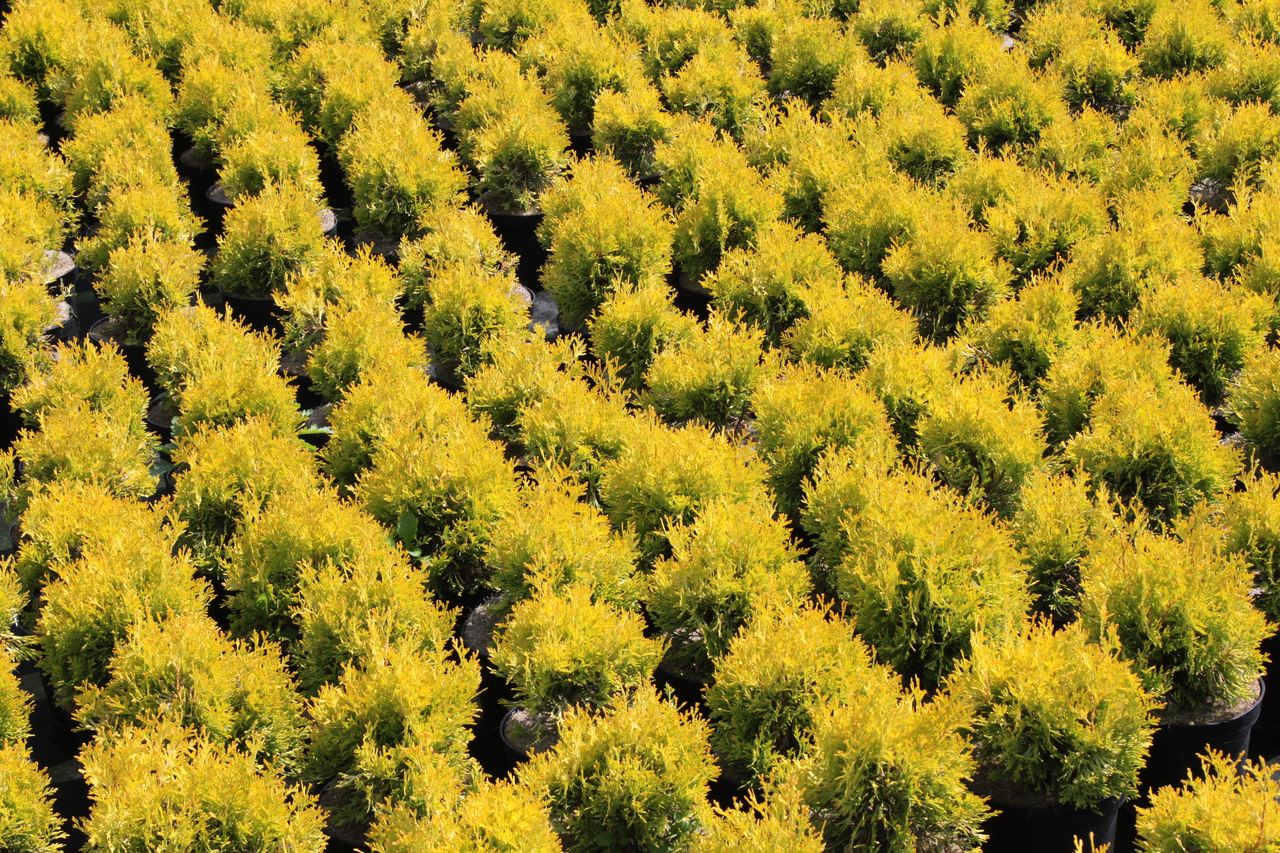
This bright yellow tree has foliage that turns a rich amber shade in the winter, providing visual interest all year round. In fact, the name ‘Jantar’ comes from this tree’s native Poland, where “jantar” means “amber.”
‘Jantar’s’ habit is narrow and upright with dense branches and foliage.
This tree grows approximately 6”-12” per year, reaching 15’ high and 3’ wide at full maturity.
‘Jantar’ grows well in full sun and well-drained soils.
This specimen is used as a lawn tree, privacy screen, or landscape accent.
Gingko biloba ‘Snow Cloud’
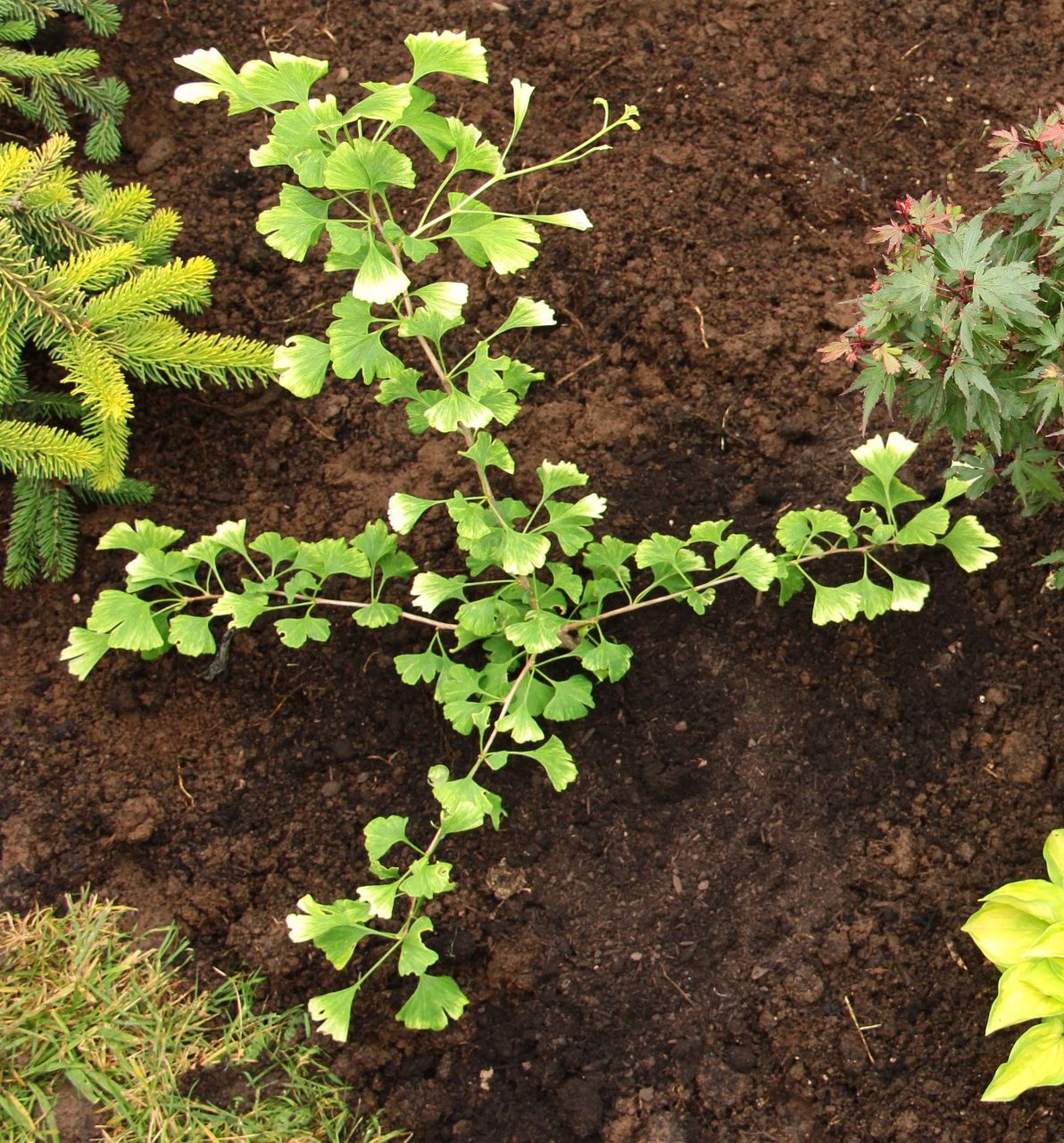
The Snow Cloud Maidenhead Tree has leaves that are a creamy yellow-white on their tips. The leaves retain the creamy color, never turning fully green. In the fall, the foliage becomes bright gold.
The leaves on this tree are broader than those of many other conifers, and the tree itself has an open and structural form. Growers may wish to stake it to encourage a particular shape or habit.
Annually, Snow Cloud grows 6”-12”. After ten years, it will be roughly 10’ tall by 4’ wide, depending on its training.
Snow Cloud grows well in part shade and well-drained soils.
This specimen is used as a garden or landscape accent.
Pinus cembra ‘Herman’
Prairie Statesman® Swiss Stone Pine
This relatively new Swiss Stone Pine cultivar has emerald green needles with silver-blue highlights. The needles are longer and stiffer than the needles found on other pine species.
‘Herman’ has a narrow, upright form. Its branches grow upward and curve inward and are very dense. Pruning is not necessary to maintain its form.
This tree grows approximately 6”-12” per year. After ten years, it will be approximately 10’ tall.
‘Herman’ is cold and drought-tolerant, but does best in full sun and well-drained soils.
This specimen is used as a lawn tree or privacy screen.
Pinus parviflora ‘Tanima no yuki’
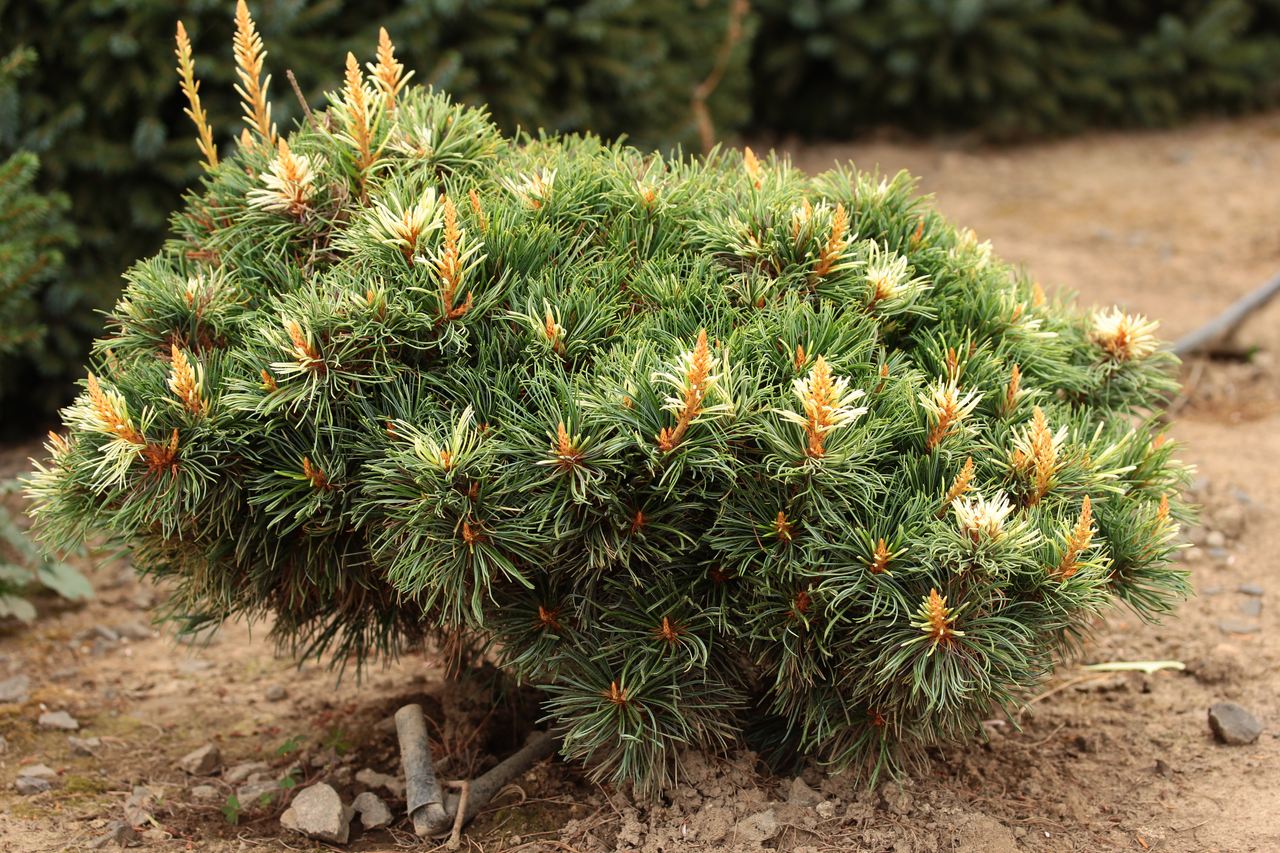
This unusual Japanese White Pine produces pink candles in the spring. Its new growth is a creamy, pinkish-white color that contrasts nicely with its mature gray-green foliage.
Tanima No Yuki has a globose or pyramidal form with cushion-shaped branching patterns.
This tree grows slowly, approximately 3”-6” per year. At maturity, it will reach about 3’ high and 1.5’ wide.
Tanima No Yuki is susceptible to sunburn, so grows best in part shade and well-drained soils.
Because of its color, this specimen is used as a garden or landscape accent.
Metasequoia glyptostroboides ‘Schirrmann’s Nordlicht’
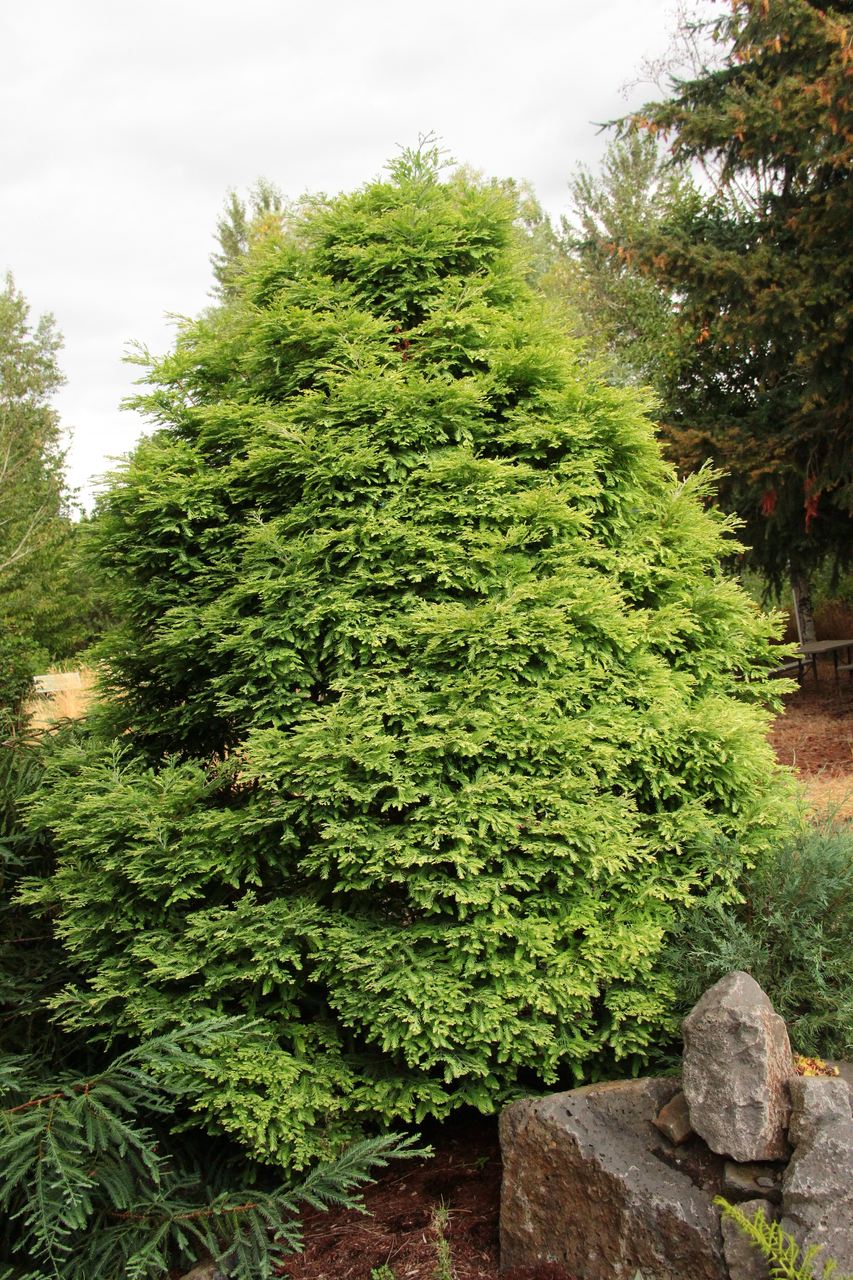
This Dawn Redwood tree has fern-like foliage that is creamy-yellow as it emerges and turns green as it ages. North Light is deciduous, and its foliage will turn brown before shedding.
North Light’s branches have reddish highlights, which add to its visual interest. Its growth habit is globose or pyramidal.
This tree grows about 3”-6” per year. After ten years, it will be approximately 3’ tall and 3’ wide. It handles pruning well.
North Light is susceptible to sunburn, so grows best in part shade and well-drained soils.
Because of its color, this specimen is used as a garden or landscape accent.
Pinus × schwerinii ‘Wiethorst’
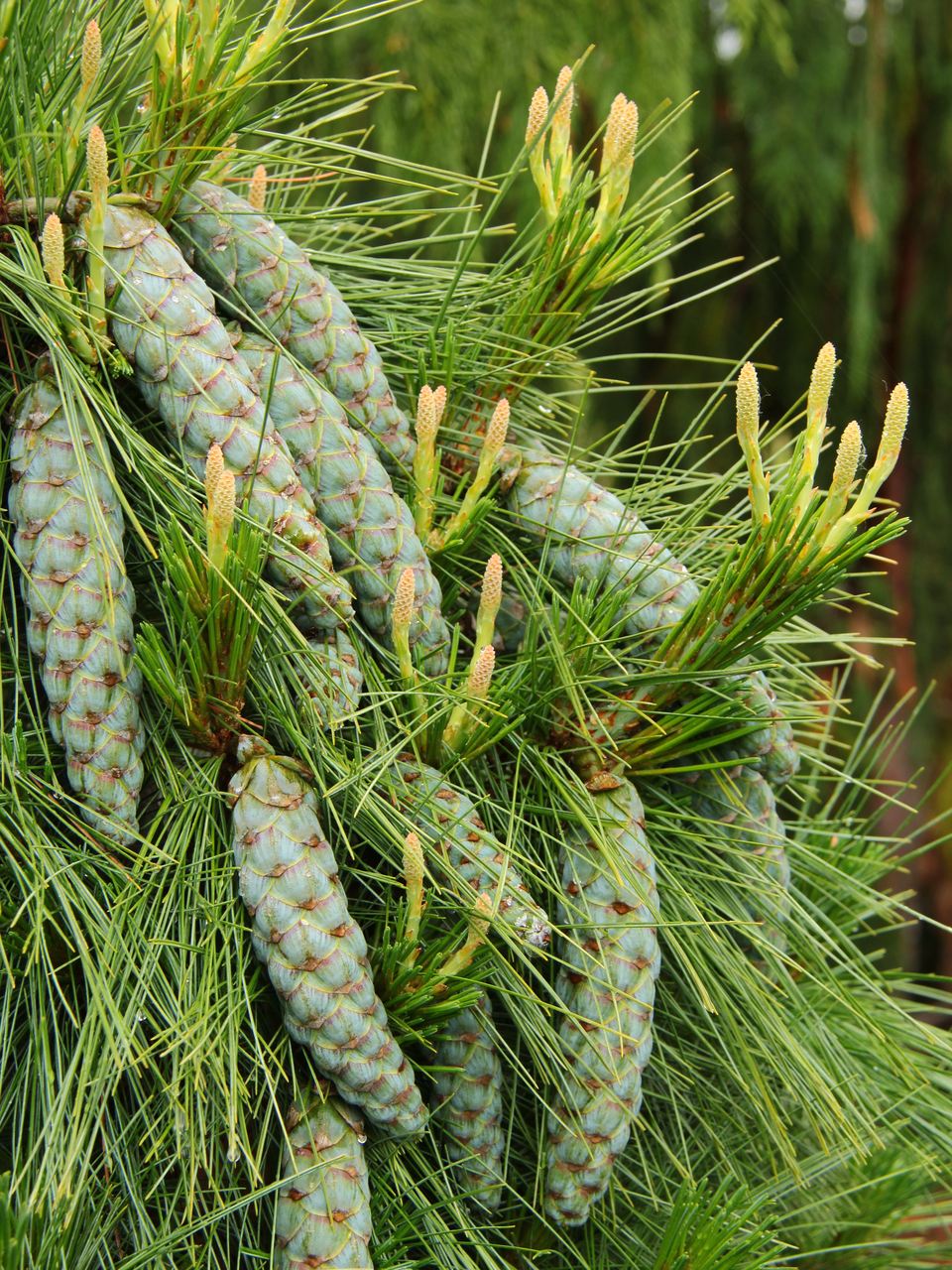
This pine hybrid features clusters of blue-green needles that are long and delicate. Its cones are creamy-pink when new and become oversized as they develop.
Wiethorst has an upright, pyramidal form. It handles pruning well. If the tree grows unpruned, it will create its own unique, pillowy shape.
Annually, Wiethorst grows approximately 3”-6”. After ten years, it will be approximately 5’ tall and 3’ wide.
This tree grows well in full sun and well-drained soils.
Wiethorst is used primarily as a garden or landscape accent.
Abies koreana ‘Kohout’s Icebreaker’
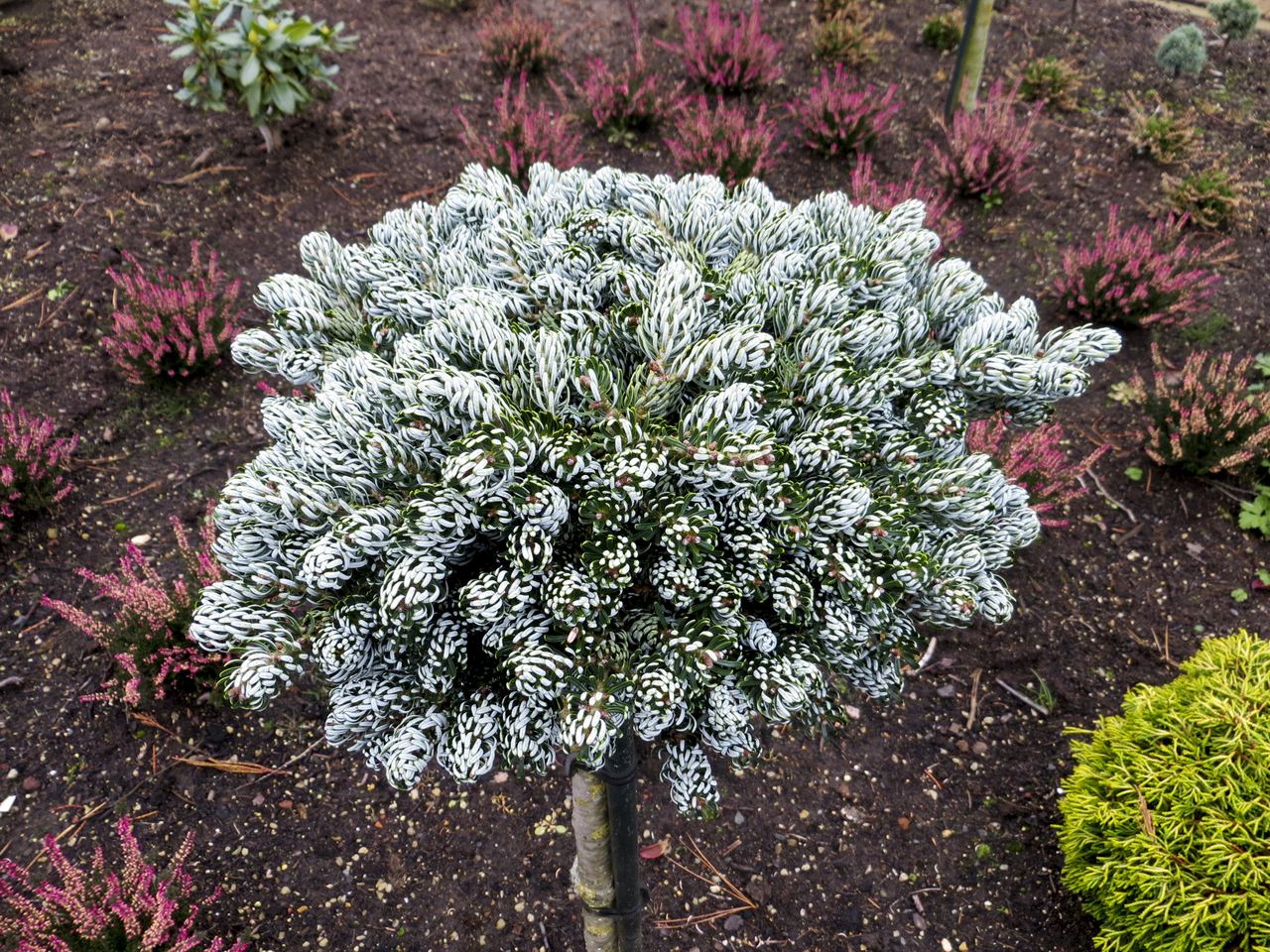
This Korean fir’s needles are green, but twist severely around their branches. The needles have silvery-white undersides which show very clearly, giving the tree a constant snow-dusted look.
When young, Kohout’s Ice Breaker is globose in form, but becomes more pyramidal as it matures. It does not require pruning.
This tree is very slow-growing, only gaining 1”-3” per year. After ten years, it will be about 2’ high and 3’ wide.
Kohout’s Ice Breaker grows best in full sun and slightly acidic, well-drained soils.
This specimen is used primarily in small gardens, rock gardens, or containers.
Picea abies ‘Gold Drift’
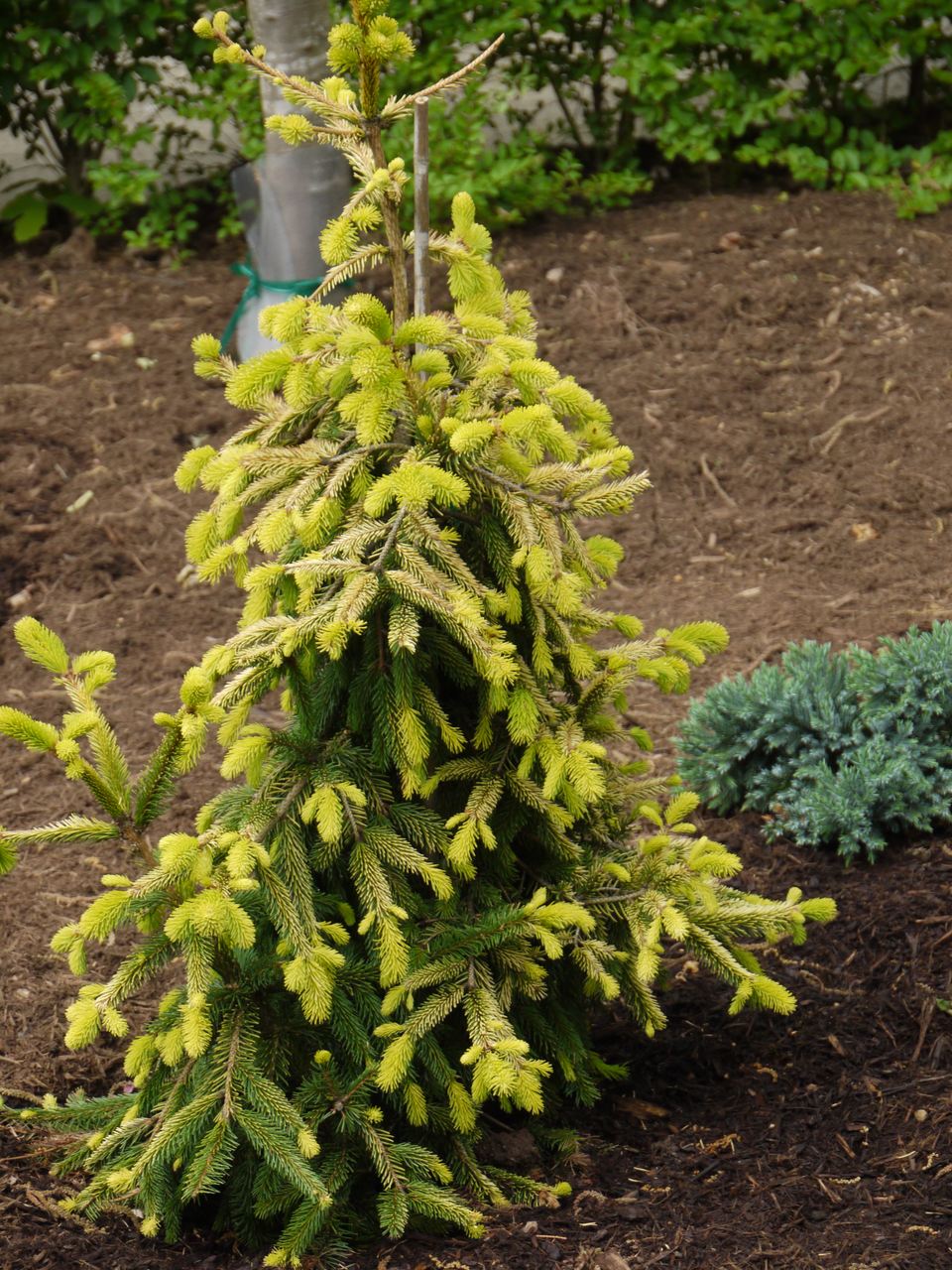
This interesting spruce has lime green needles that turn bright yellow in full sun. The needles are short and stiff.
Gold Drift has pendulous branches and a decidedly weeping habit. If it’s staked, it can be trained to grow upright; if left to its own devices, it will stay low and mound.
This tree grows rapidly, over 12” per year. If staked, it will be approximately 12’-15’ tall and 2’ wide after ten years.
Gold Drift grows best in full sun and slightly acidic, well-drained soils.
This specimen is used primarily in small gardens, as a lawn tree, or as a landscape accent.
Pinus mugo ‘Carstens’
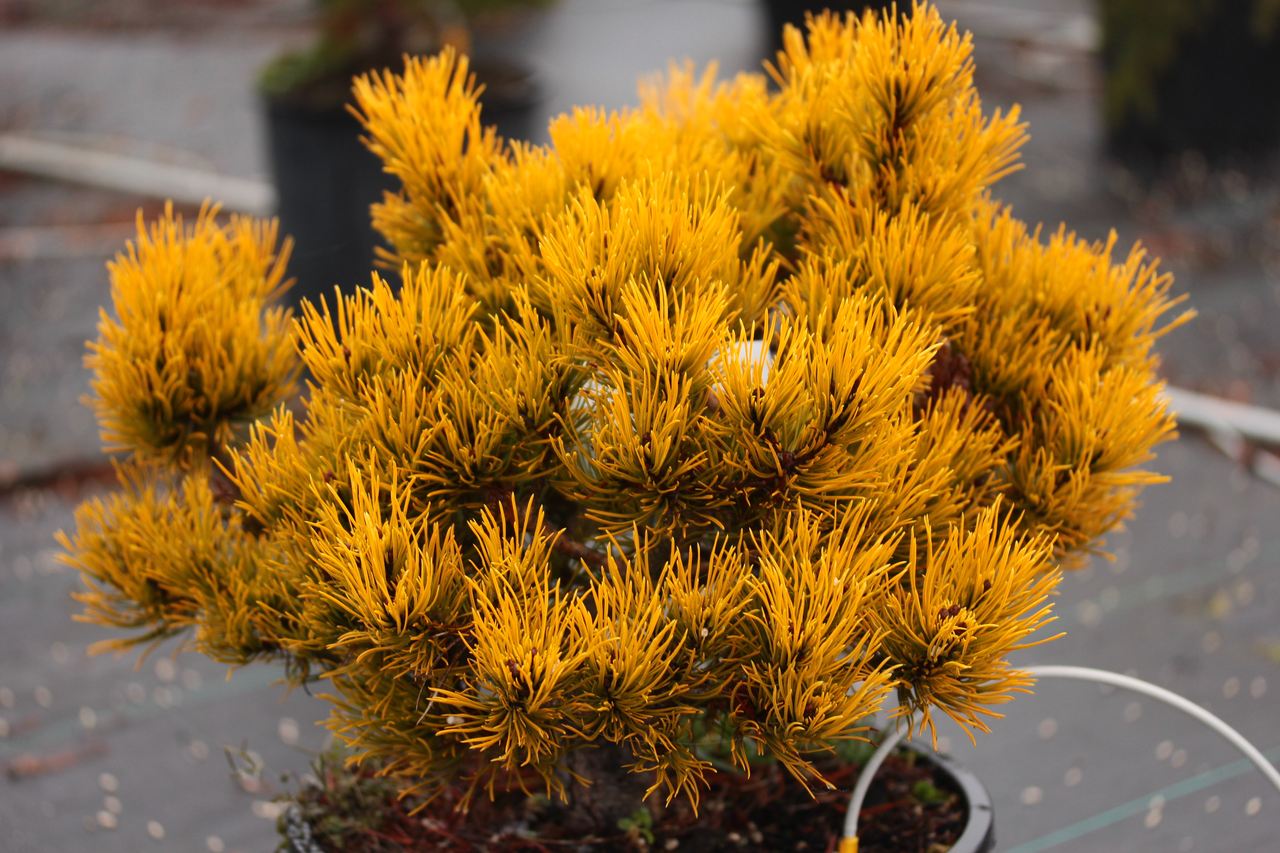
This Mountain Pine is aptly named, as it features compact clumps of short green needles that turn bright gold in winter.
Carstens’ growth habit is dense and cushion-shaped.
A slow grower, Carstens adds only about 1”-2” of new growth annually. After ten years, it will be 1’-2’ tall and wide.
Carstens grows best in full sun and well-drained soils. It is tolerant of a variety of pH levels and soil types.
This specimen is used primarily in small gardens and rock gardens.
Cunninghamia konishii ‘Little Leo’
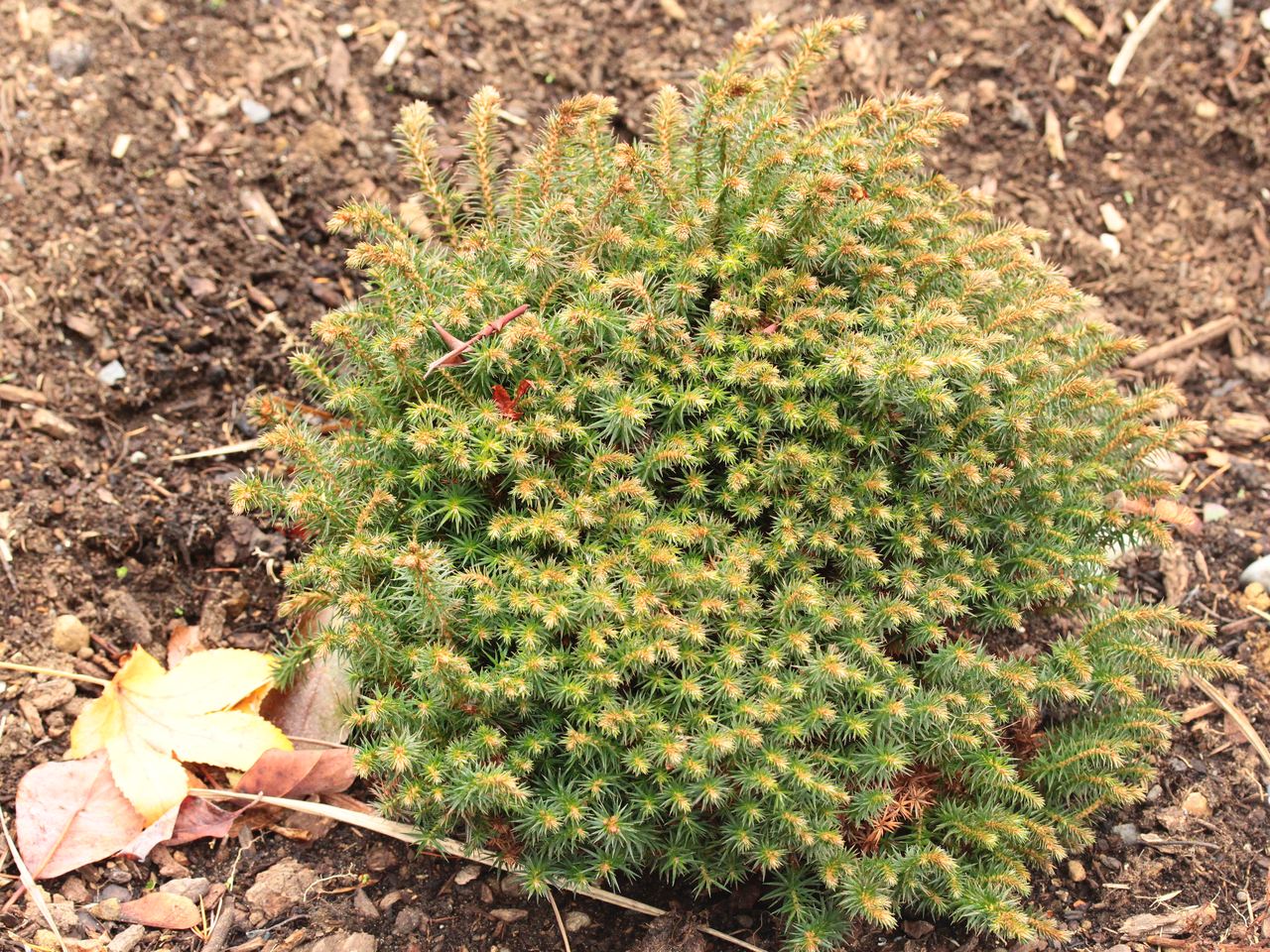
This very rare shrub features very short, prickly needles that are green during the summer and take on bronze overtones in the winter.
Little Leo’s branchlets are twisting. Its growth habit is cushion-shaped, with a somewhat flattened top.
This shrub grows 1”-1.5” per year. At full maturity, it is quite small, only about 6” tall and 12”-18” wide. Dead foliage from the internal branches will need to be cleared out once a year to help the plant stay healthy.
Little Leo grows well in full sun and well-drained soils.
This specimen is used primarily in small gardens, rock gardens, and containers.
Sciadopitys verticillata ‘Picola’
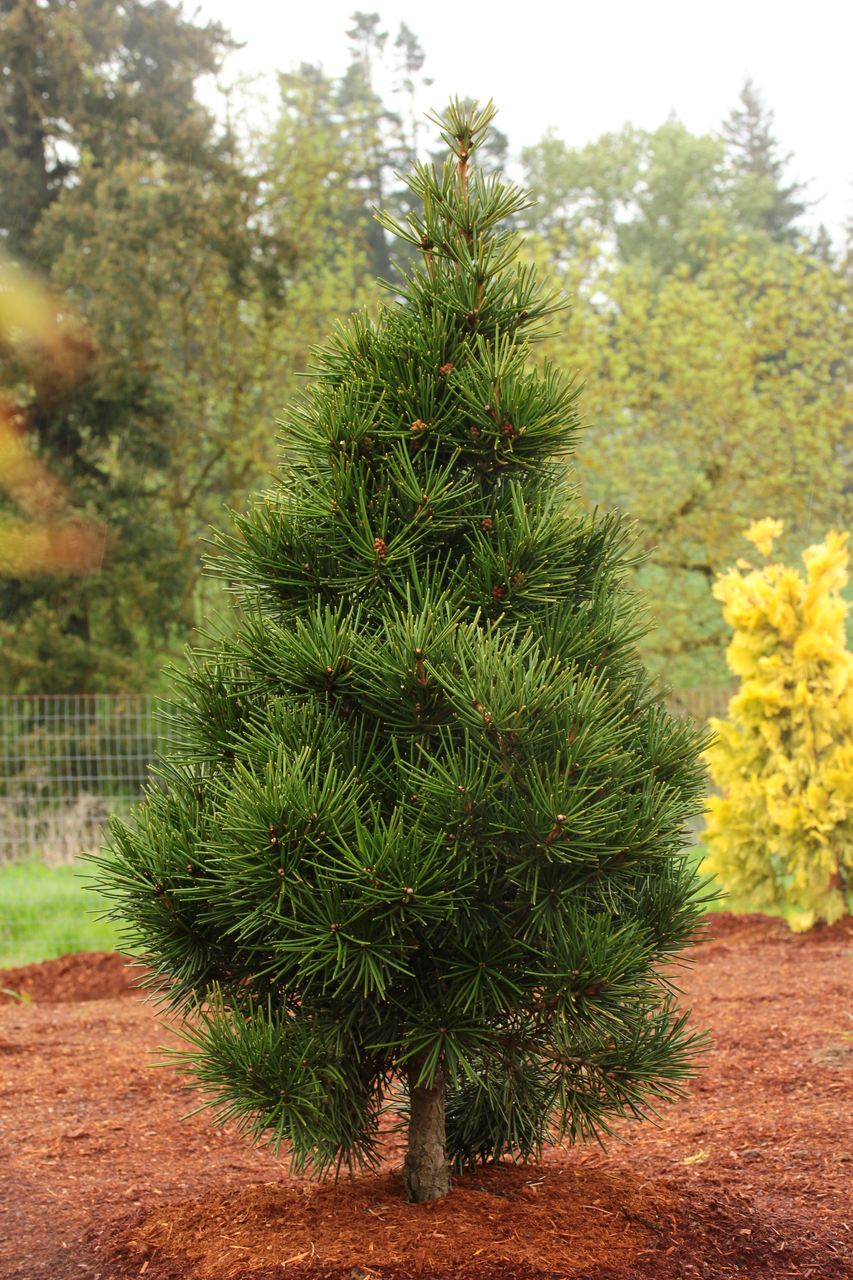
This Japanese Umbrella Pine features short, thin, dark-green needles.
Picola has dense, compact branches that give it a bushy habit. Its form is upright and broad.
This tree grows approximately 3”-5” per year. After ten years, it will reach 4’ tall and 3’ wide.
Picola grows well in full sun or partial shade and well-drained soils.
This specimen is used primarily as a garden or landscape accent.
Cedrus brevifolia ‘Kenwith’
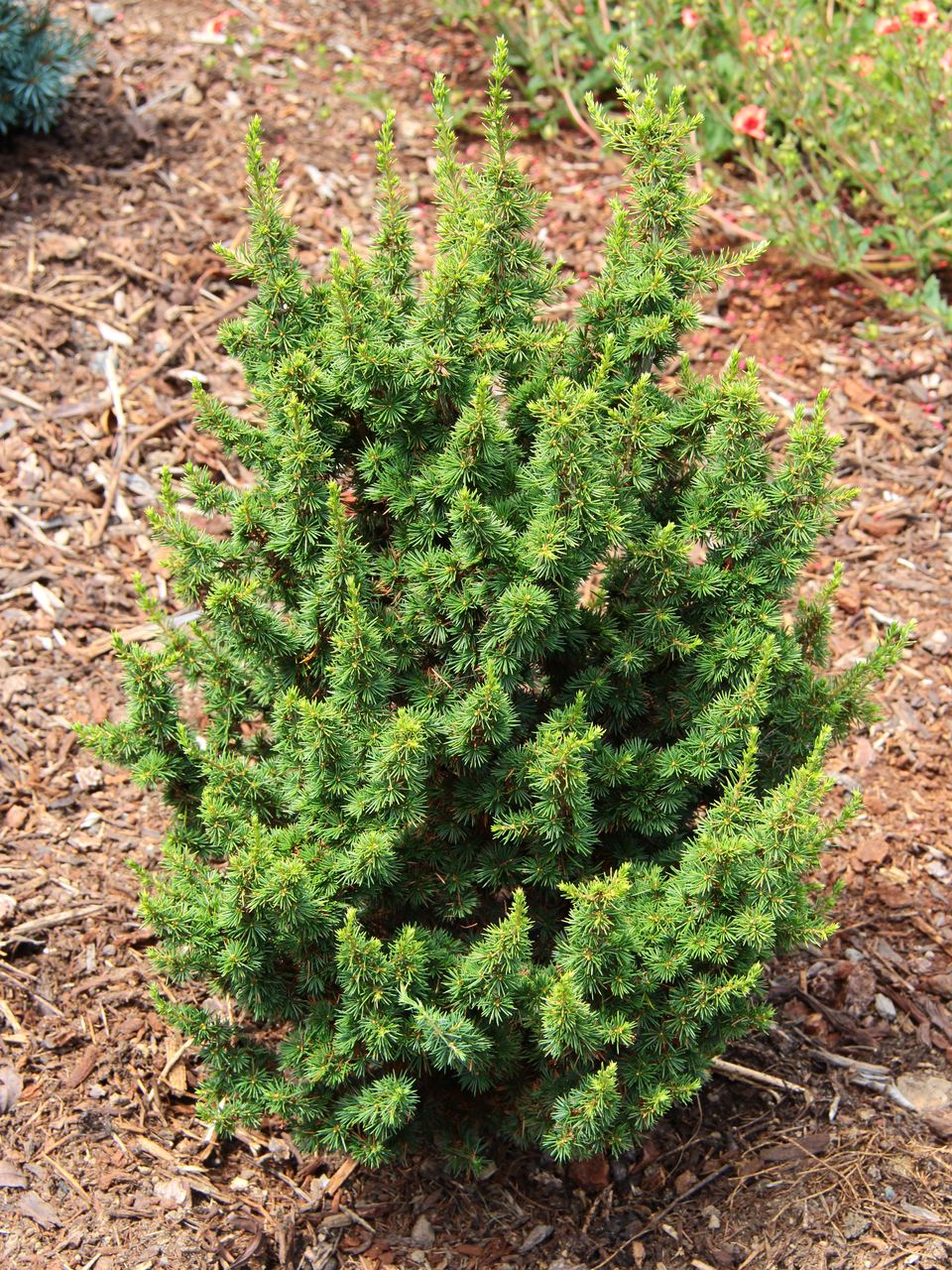
This Lebanese Cedar has small, lush green needles. Its appearance is similar to Bonsai trees.
Kenwith’s branches are stubby and curve inward. Its mature form is broad and upright.
This tree grows about 1”-3” per year. After ten years, it will be approximately 2’ tall and 1.5’ wide.
Kenwith grows well in full sun or partial shade and well-drained soils.
Because of its small size, this specimen is used primarily in small gardens, rock gardens, and containers.
Picea abies ‘Wichtel’
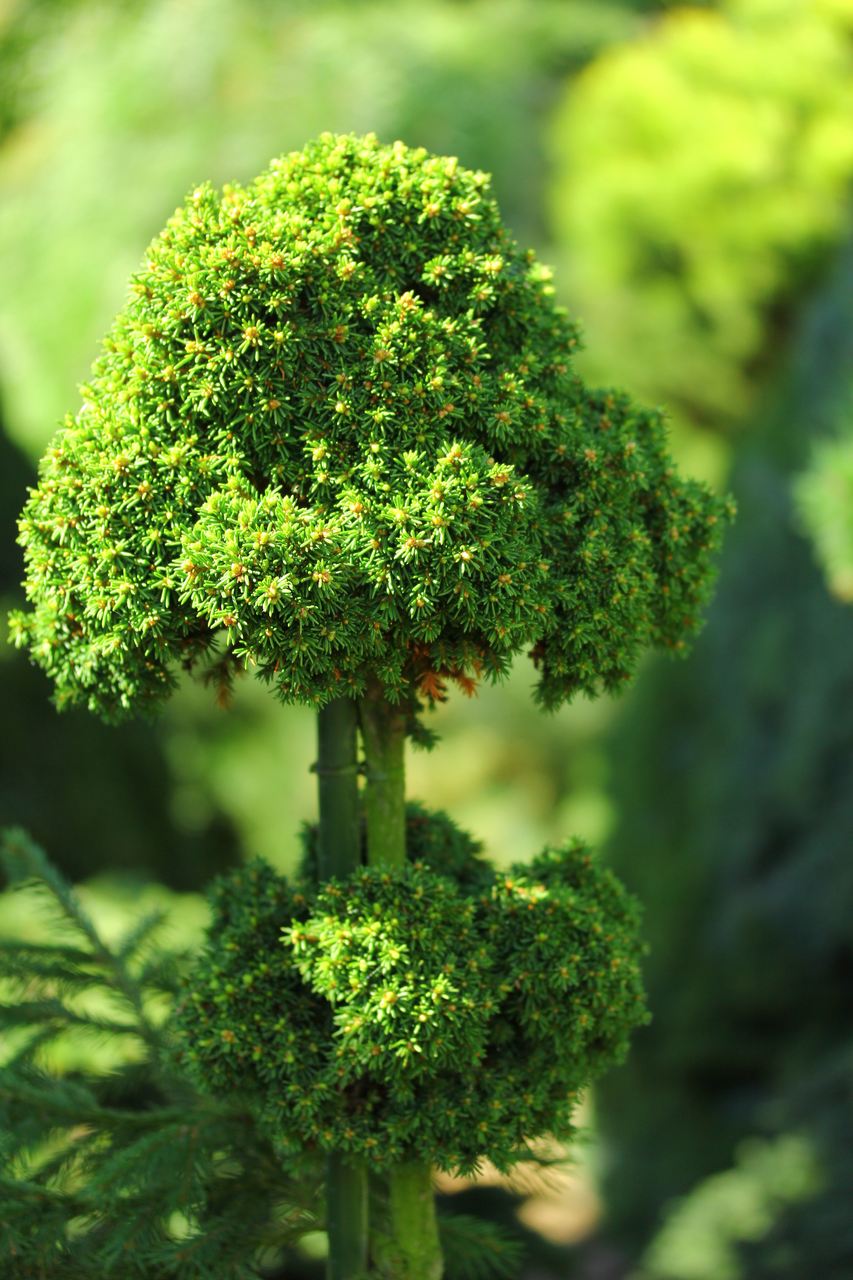
This miniature tree features very short dark-green needles.
Wichtel’s growth habit is cushion or bun-shaped. It has a tight, congested branching structure. To protect the plant’s health, dead foliage and branches must be cleared out annually.
The name ‘Wichtel’ comes from the German word for “gnome,” which is appropriate given this tree’s size. Its growth rate is less than 0.5” per year, and at full maturity, it is only about 3”-4” tall and wide.
Wichtel is prone to sunburn, but too much shade can lead to rot. Partial shade and well-drained soils are best.
Because of its size and sunlight needs, this specimen is primarily grown in containers.
Pinus parviflora ‘Bergman’
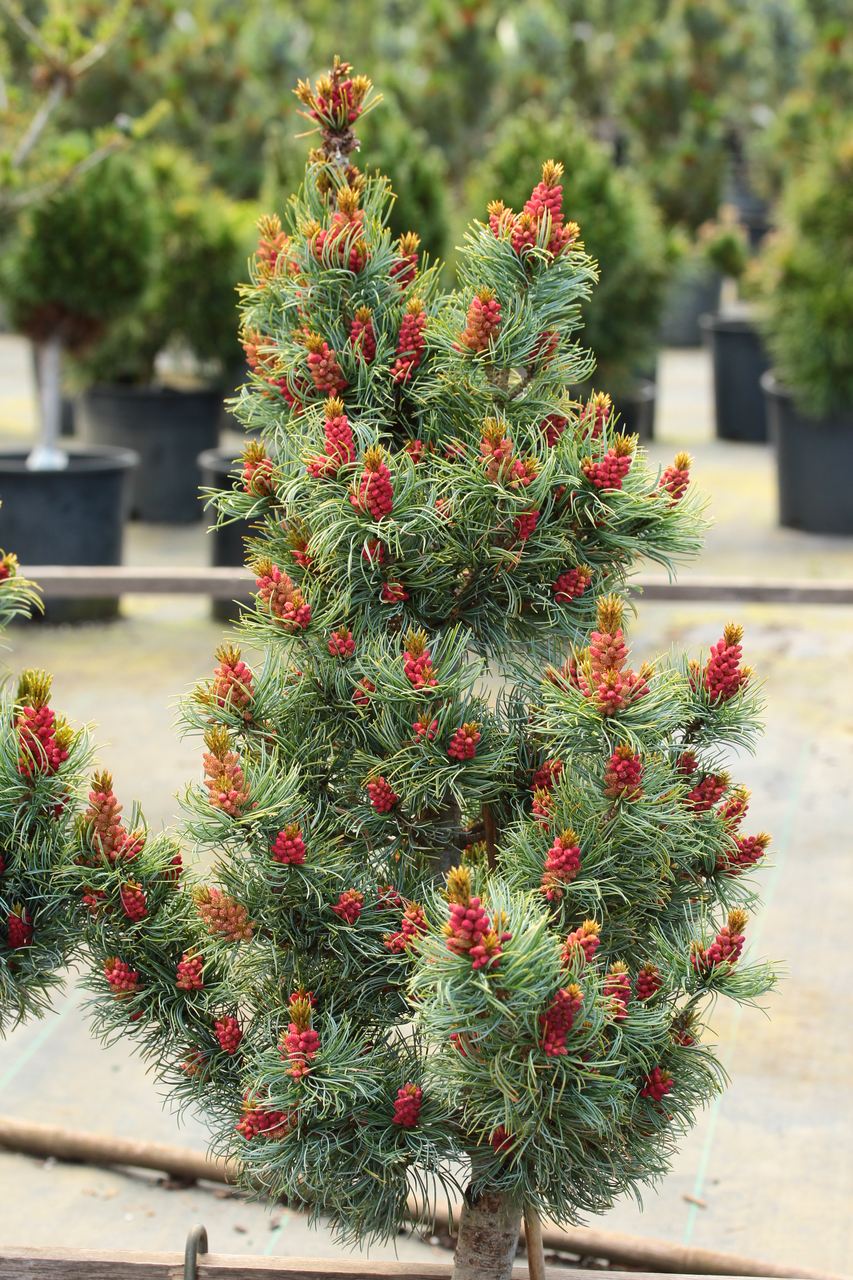
This Japanese White Pine has twisting, blue-green needles. In the spring, it has an abundance of bright red cones that add contrast and visual interest.
Bergman has a broad upright or pyramidal form. Its branching structure is dense.
This tree grows 6”-9” per year. At full maturity, it stands 6’ tall and 3’ wide.
Bergman grows well in full sun and well-drained soils.
This specimen is primarily used as a lawn tree or landscape accent.
Chamaecyparis obtusa ‘Chirimen’
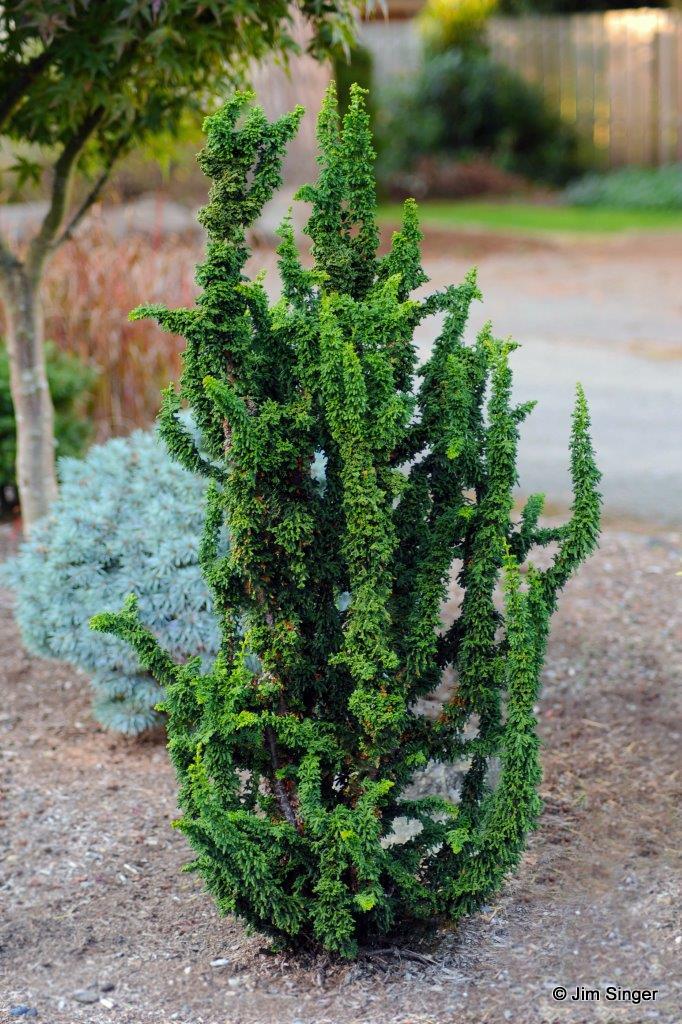
This unique tree has variegated blue-green foliage. The foliage is also crinkly and congested, providing a mix of textures as well. In fact, the name ‘Chirimen’ comes from the name of a Japanese crepe fabric that resembles the texture of this tree’s leaves.
Chirimen’s branches are thick and upright. With the dense foliage, each shoot creates a bottlebrush shape.
This tree grows 3”-5” per year. At full maturity, it will stand 4’ tall and 2’ wide.
Chirimen grows well in full sun or partial shade and must have excellent drainage.
This specimen is used primarily as a garden or landscape accent.
Gingko biloba ‘Mariken’
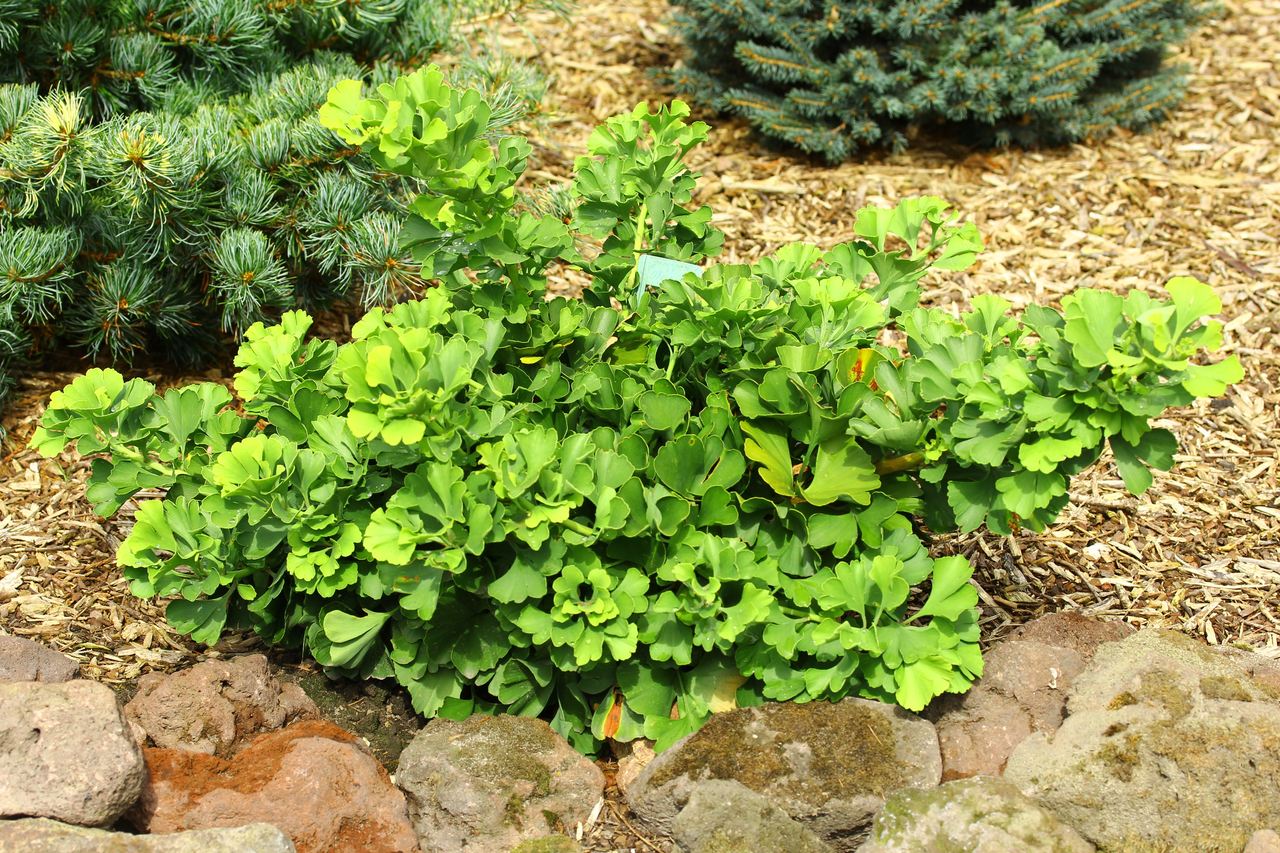
This Maidenhair tree has leaves of varying size and varying shades of green. In the fall, the leaves turn an orange-gold color. The foliage grows densely.
Mariken’s branches are semi-pendulous and compact. It has a spreading habit that eventually takes the shape of a somewhat flattened sphere.
Annually, this tree grows 3”-4”. After ten years, it will be roughly 2’ tall and 2.5’ wide.
Mariken grows well in full sun and well-drained soils.
This specimen is used primarily in small gardens, rock gardens, and as a landscape accent.
Larix decidua ‘Puli’
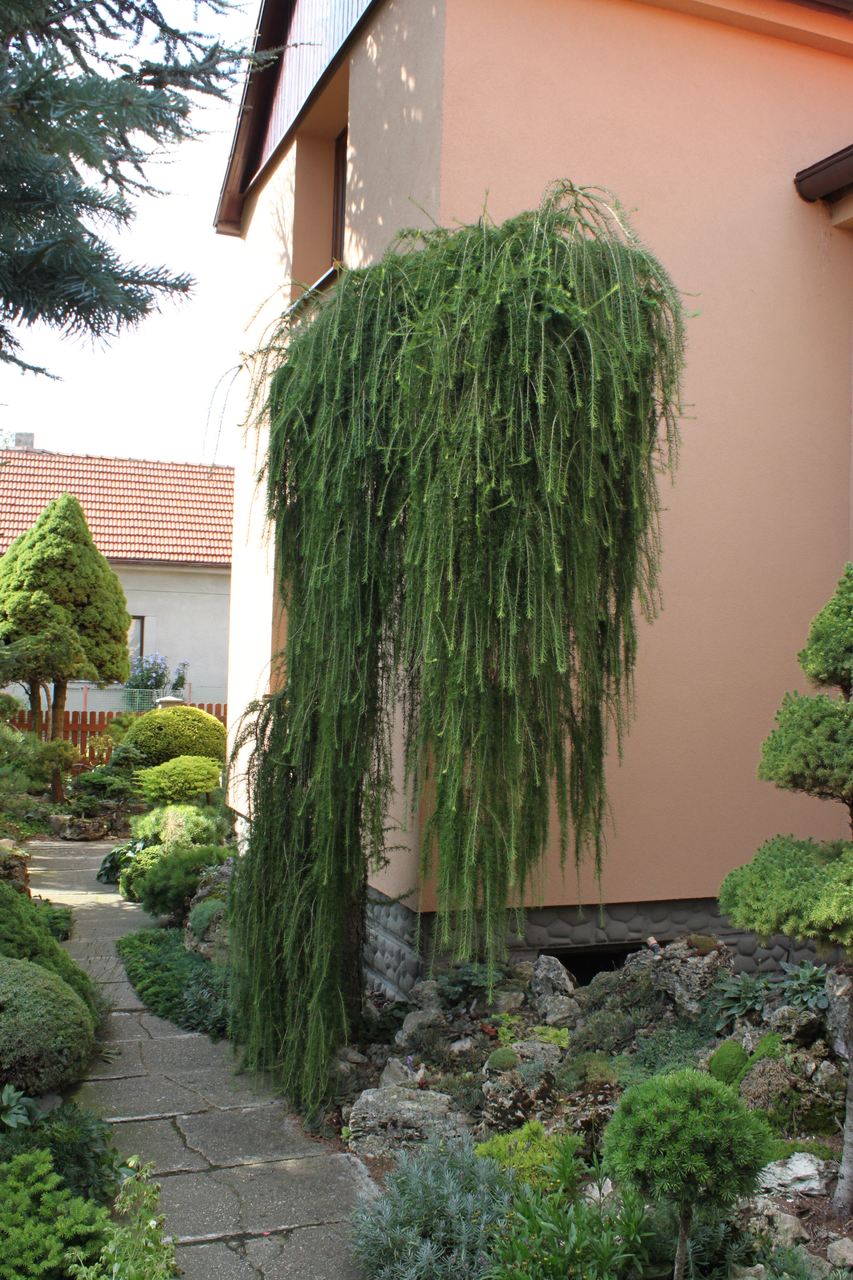
This elegant tree features light-green, lacy, cascading foliage. In the fall, the foliage turns yellow before shedding.
Puli’s branches are delicate, slender, and decidedly weeping. It has a spreading habit, and when staked, it can be trained to grow upright to a desired height. If the tree is left unstaked, it works well as a ground cover.
This tree grows 12”-15” per year. Because it will not grow upright without a stake, its mature height will vary.
Puli grows well in full sun and well-drained soils.
This specimen is used primarily as a garden or landscape accent.
Taxodium distichum ‘Pevé Minaret’
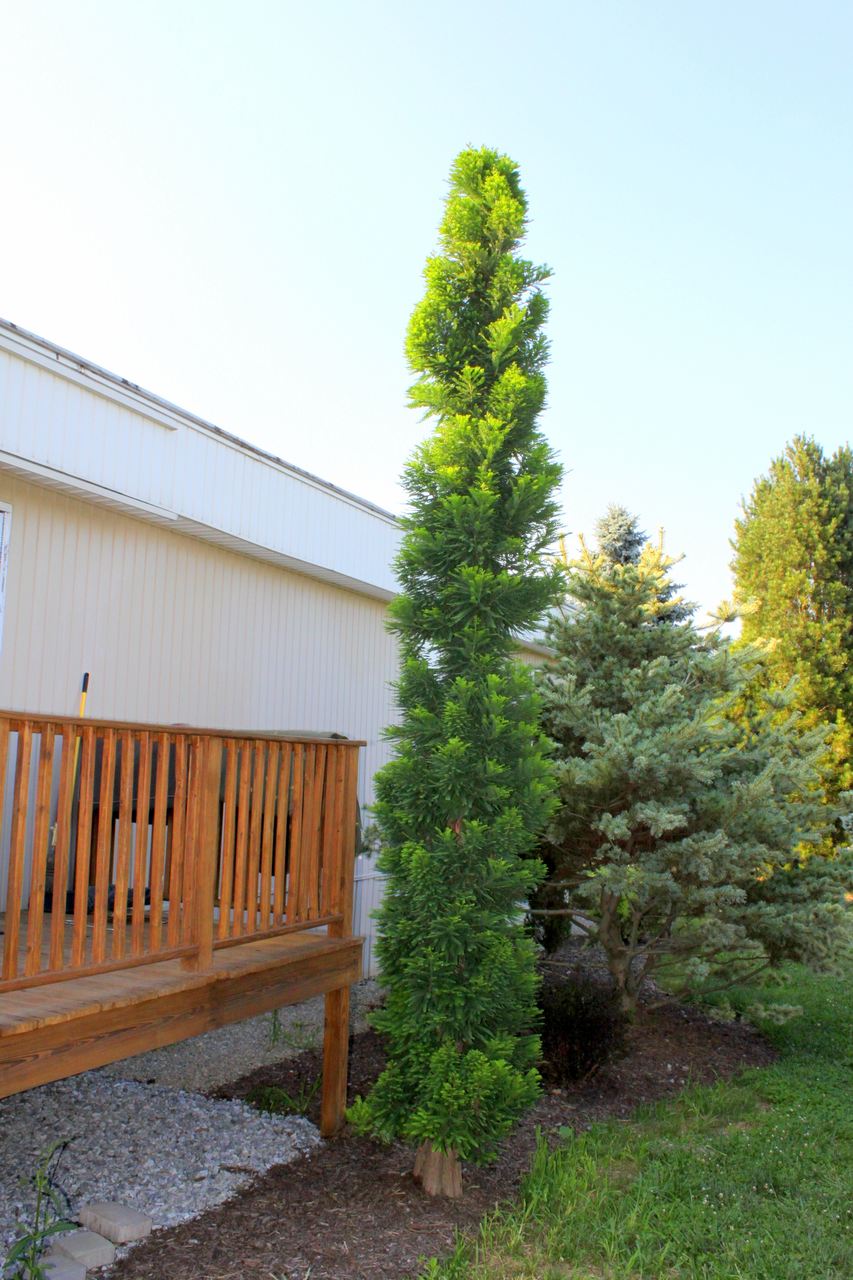
This dwarf Bald Cypress grows small tufts of lush green foliage.
Pevé Minaret’s branches are dense. Its growth habit is narrow and conical. It can be pruned to encourage new growth.
This tree grows roughly 3”-6” per year. After ten years, it stands approximately 4’ high and 3’ wide.
Pevé Minaret grows well in full sun and well-drained soils.
This specimen is used primarily as a garden or landscape accent.
Pinus heldreichii ‘Smidtii’
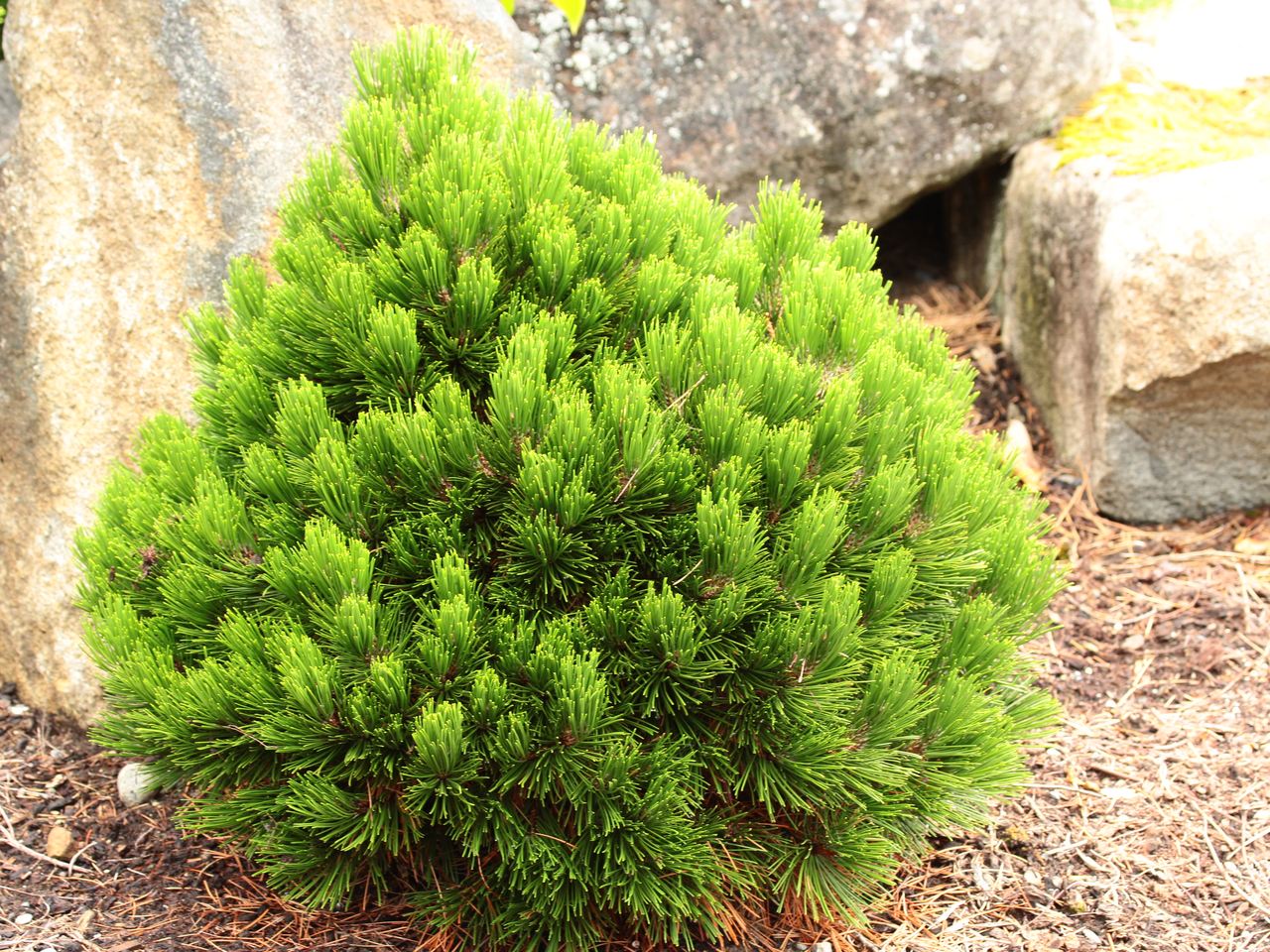
This Bosnian Pine features green needles that are sharp, rigid, and point upward.
Smidt’s branching structure is dense and compact. Young trees are globose, but become more conical as the mature.
This tree grows very slowly, only about 1” per year. After ten years, they reach 12”-18” tall and wide. No pruning is required.
Smidt grows well in full sun and well-drained soils.
Because of its small size, this specimen is used primarily in small gardens, rock gardens, and containers.
Pinus strobus ‘Niagara Falls’
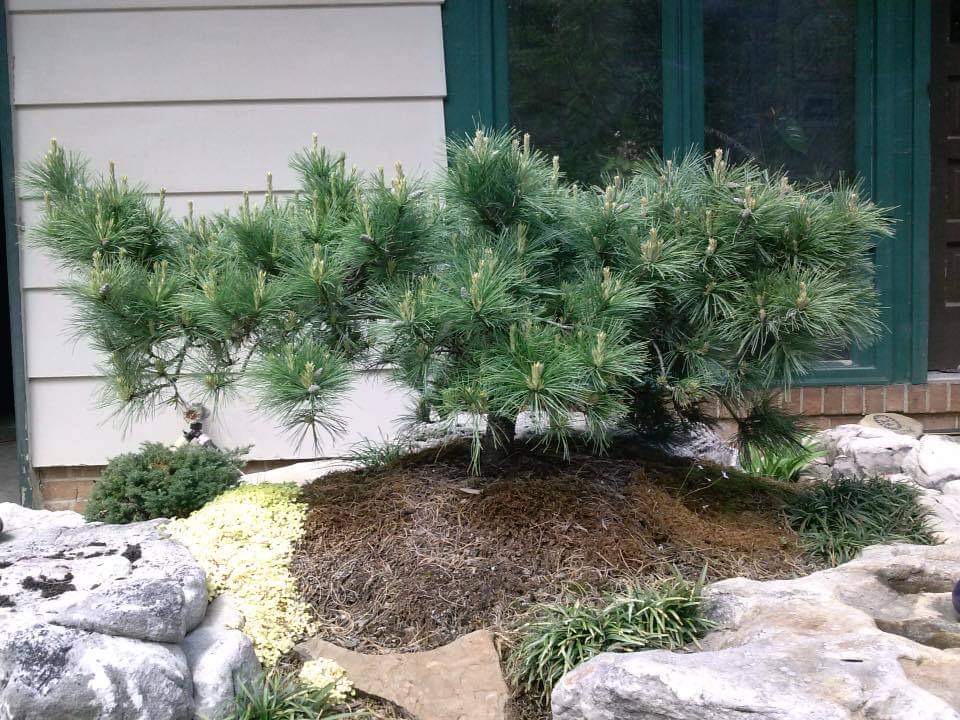
This Eastern White Pine cultivar has long blue-green needles.
Niagara Falls’ branches are semi-pendulous and weeping. This tree has a spreading habit and can be staked to a desired height before cascading downward.
Annually, this tree grows 3”-5”. Because it will not grow upright without a stake, its mature height will vary from 1’-5’.
Niagara Falls grows well in full sun and well-drained soils.
This specimen is used primarily as a garden or landscape accent.
Picea pungens ‘The Blues’
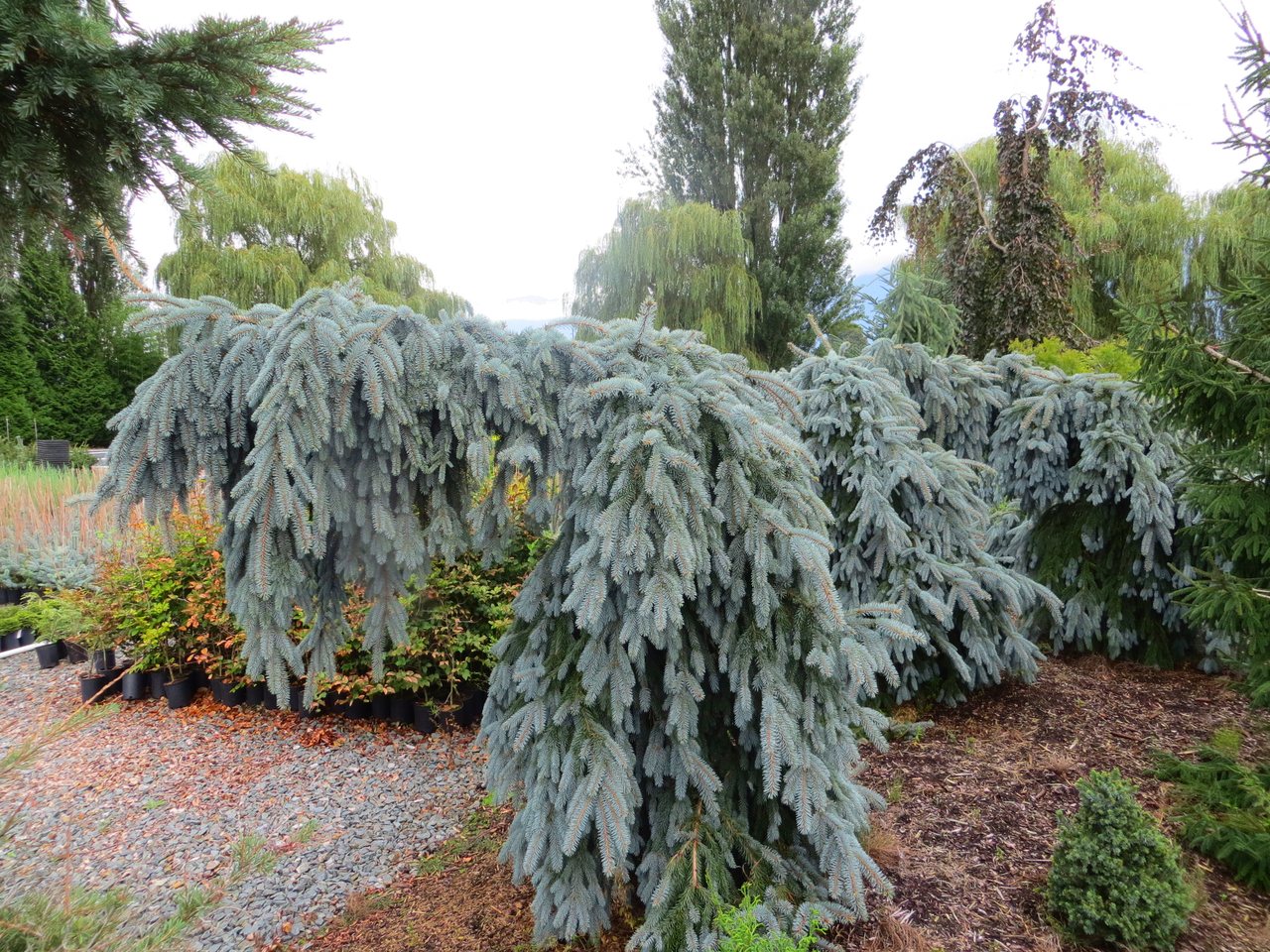
This striking Colorado Spruce tree has large, silver-blue needles.
The Blues’ branches are weeping, and as a whole, the tree has a mounding, spreading habit. Growers can stake it to a certain height, let it ramble, or train it to grow along the top of a fence or wall. No pruning is necessary.
This tree grows about 6”-12” per year. Because it will not grow upright without a stake, its mature height will vary, but it can reach heights of 5’-6’.
The Blues grows well in full sun and slightly acidic, well-drained soils.
This specimen is used primarily as a garden or landscape accent.
Picea abies ‘Pusch’
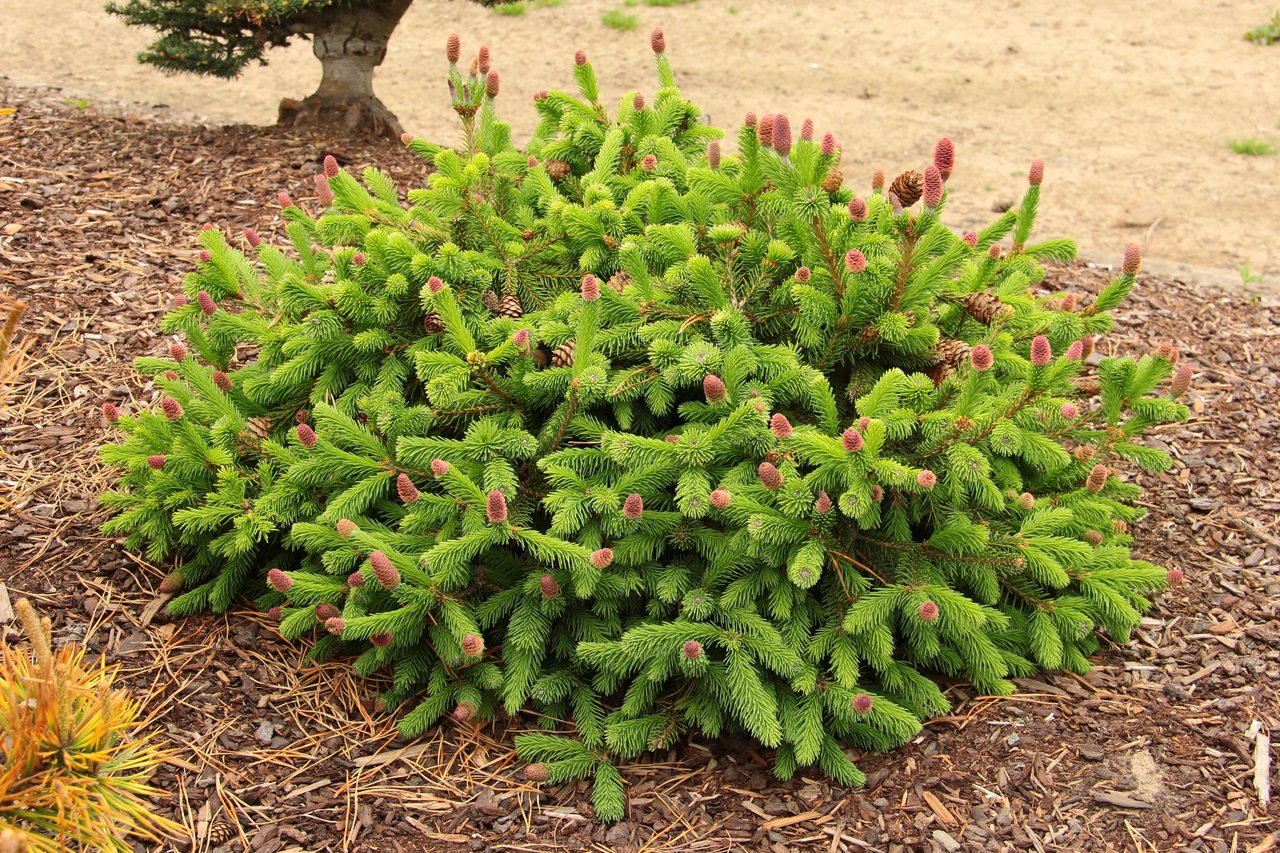
This shrub has dark green needles that are short and dense. In the spring, it produces bright red cones on the tips of most of its branches.
Pusch has layered lateral branches and a globose growth habit. It does not require pruning.
This shrub grows slowly, only about 1”-2” per year. After ten years, it will be approximately 2’ tall and 3’ wide.
Pusch grows well in full sun and slightly acidic, well-drained soils.
Because of its small size, this specimen is used primarily in small gardens, rock gardens, borders, and containers.
Picea omorika ‘Pendula Bruns’
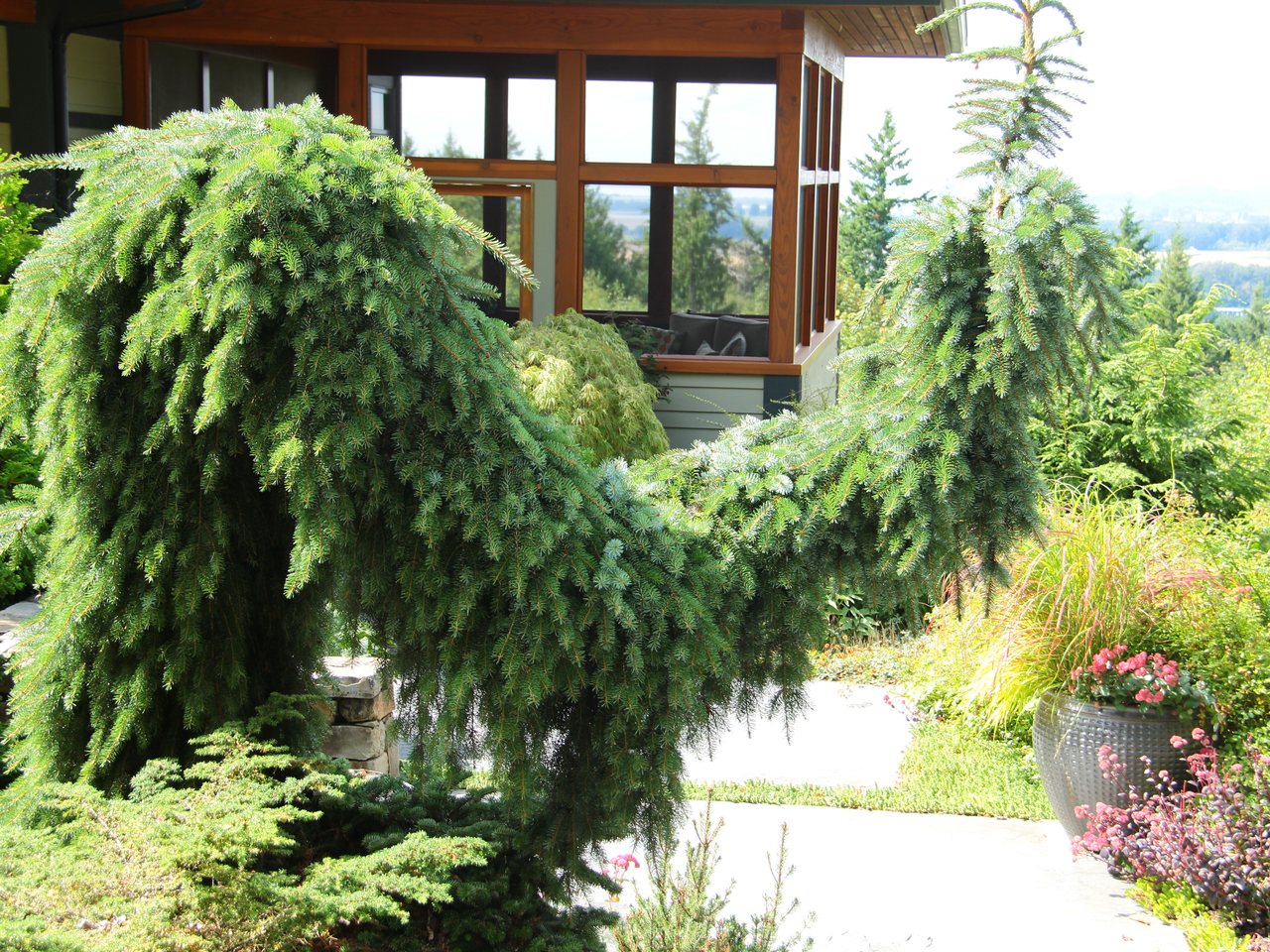
This unique Serbian Spruce is an evergreen that has lush blue-green needles.
As its name suggests, Bruns’ branches are pendulous and weeping. Its form is columnar and very narrow, with the branches cascading very near the trunk. It does not require pruning.
This tree grows approximately 6”-12” annually. At full maturity, it will stand about 15’ tall and 3’ wide. If left unstaked, it will eventually start to twist.
Bruns grows well in full sun and well-drained soils.
This specimen is primarily used as a lawn tree or landscape accent.
Picea orientalis ‘Tom Thumb Gold’
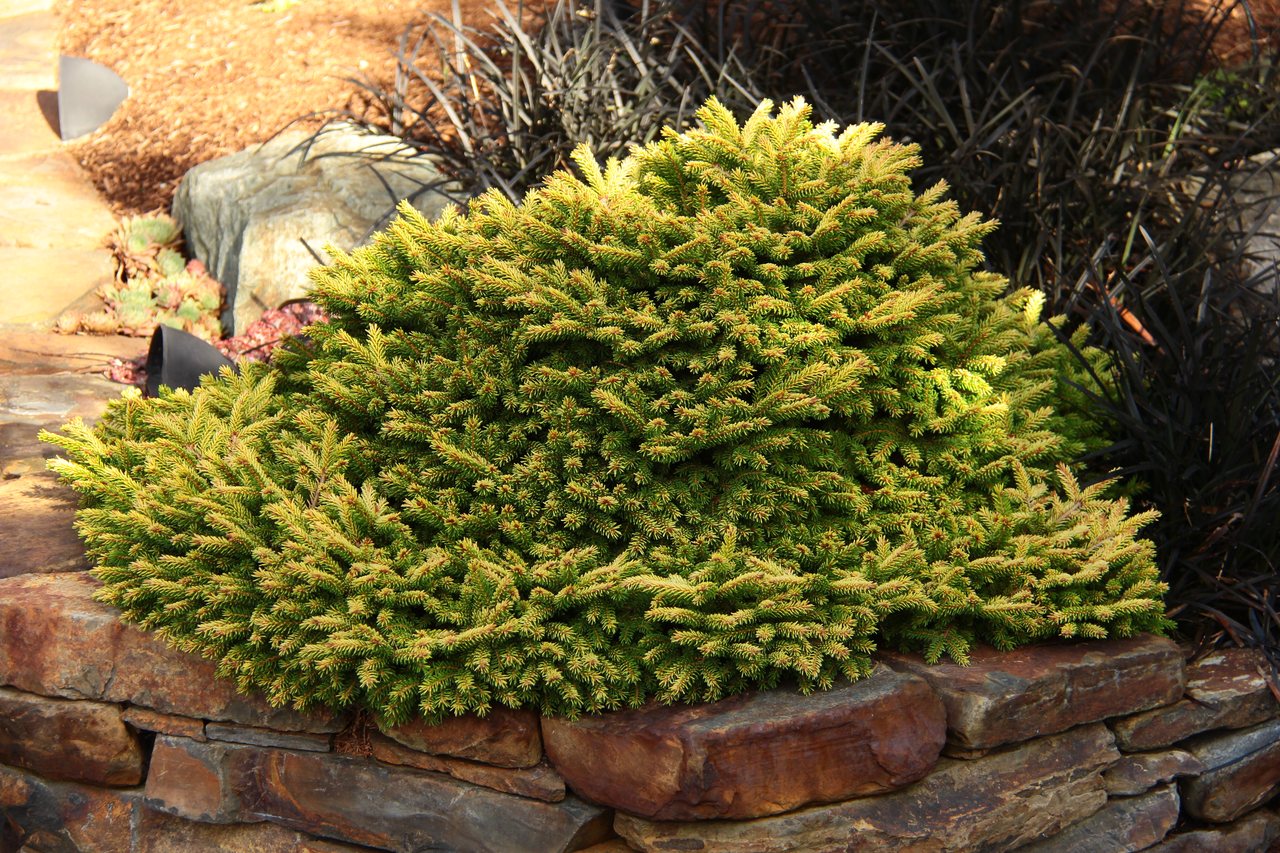
This dwarf tree has bright golden needles that are short and stiff. The needles turn green when the plant doesn’t get enough sun.
Tom Thumb Gold’s growth is compact and dense. As it matures, it forms a bun shape.
A slow grower, Tom Thumb Gold will gain 1”-1.5” per year. At full maturity, it will reach 10” high and 12” wide.
Tom Thumb Gold is prone to sunburn; however, too little sun is also harmful. Partial shade and well-drained soils are best.
Because of its small size, this specimen is used primarily in small gardens, rock gardens, and containers.
Metasequoia glyptostroboides ‘Ogon’
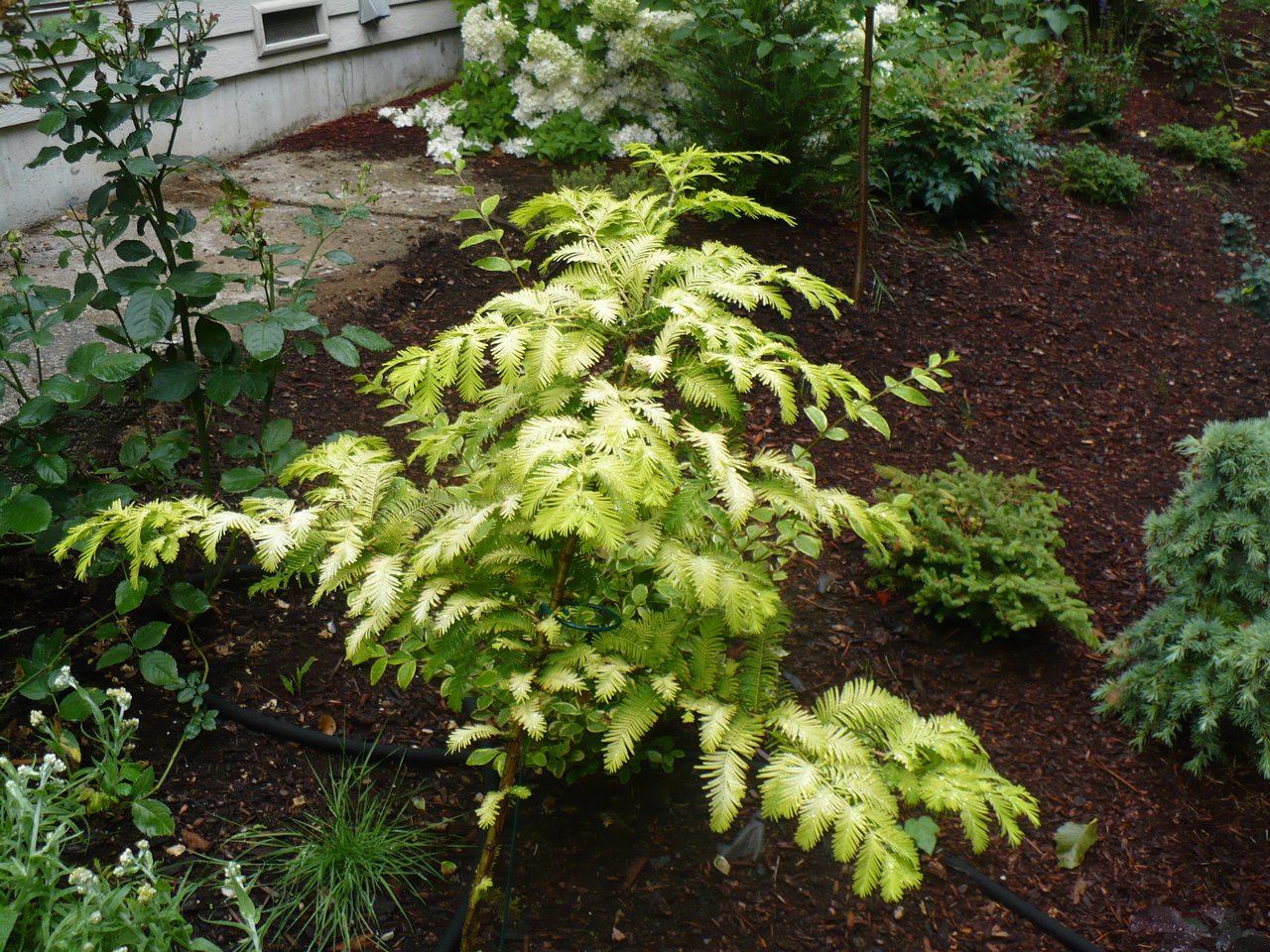
This unique conifer features delicate, bright yellow-green leaves. The foliage grows in flat, feathery sprays. In the summer, the leaves become bright gold; in the fall, they turn orange-brown before being shed.
Also known as ‘Gold Rush,’ this tree requires very little pruning to maintain its conical, upright growth habit. Branches angle upward, giving mature trees a buttressed appearance.
This tree grows rapidly, as much as 2’ per year. Its full height can be as tall as 70’-80’ with a full width of 25’-30’.
‘Ogon’ is tolerant of a variety of soils, including soils that drain poorly. Full sun or partial shade is best.
This specimen is grown primarily as a lawn tree or in groves.
Picea glauca var. albertiana ‘Pixie Dust’
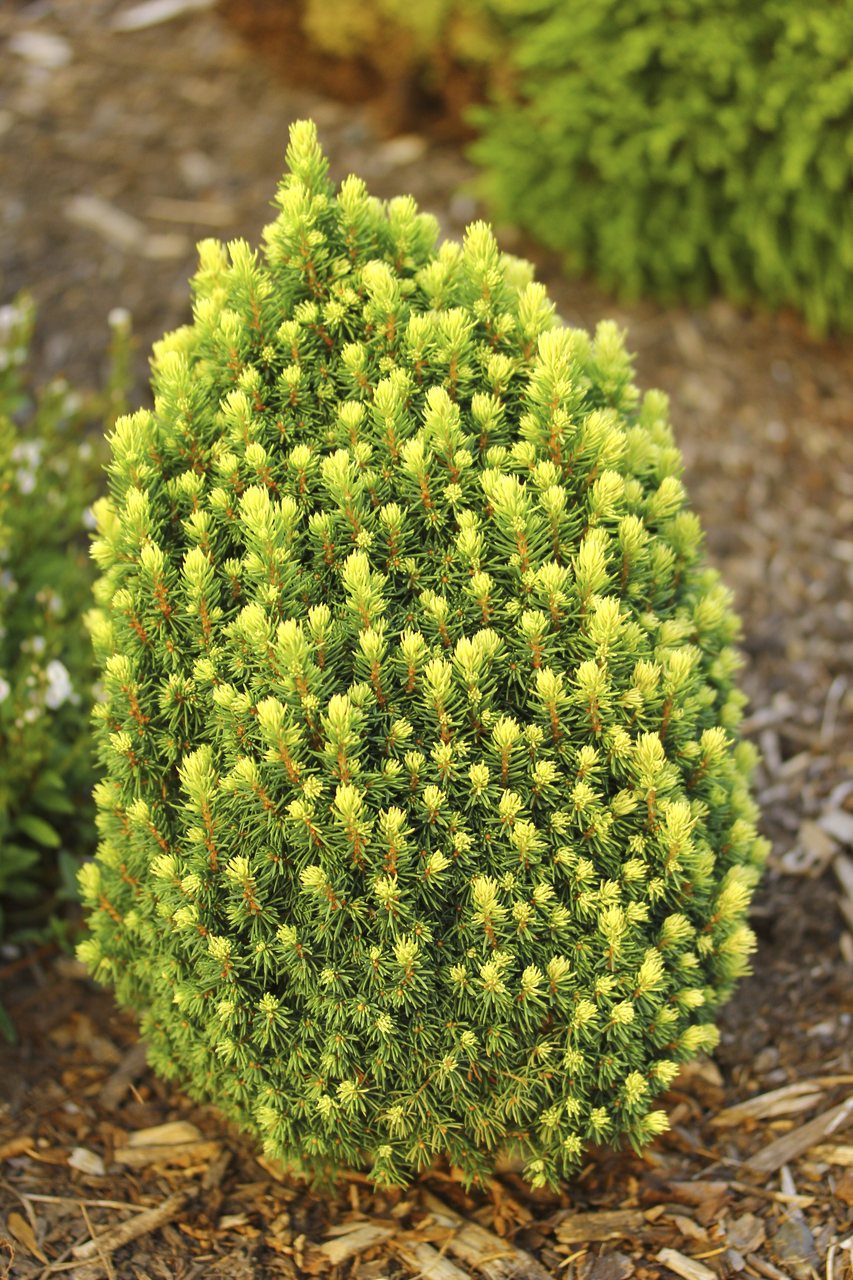
This miniature Alberta Spruce has bi-colored needles. New growth comes in the form of yellow tufts of needles that turn green as they mature. The yellow tufts at the ends of its branches are what give this tree the name ‘Pixie Dust.’
Pixie Dust’s branches are very dense and curve upward. Its form is conical without pruning.
This tree grows about 0.75”-1.5” each year. After ten years, it will be approximately 15” tall and 8” wide.
Pixie Dust grows best in full sun and well-drained soil.
Because of its small size, this specimen is used primarily in small gardens, rock gardens, and containers.
For more information on caring for dwarf conifers, please see our other articles on pruning, container growing, and basic conifer care.
For the full list of the American Conifer Society’s Conifer of the Year awards, please see here.















































































































































